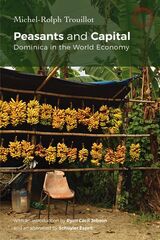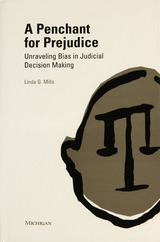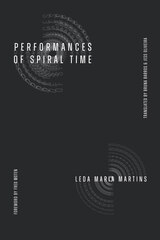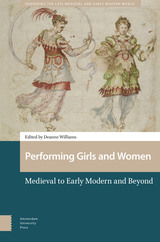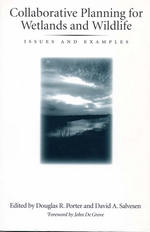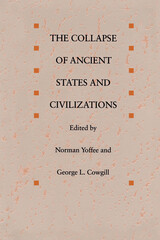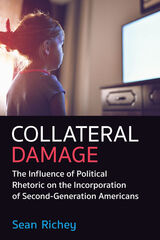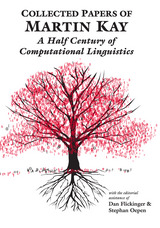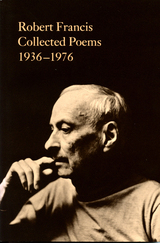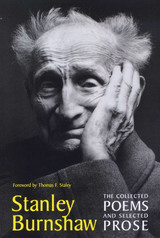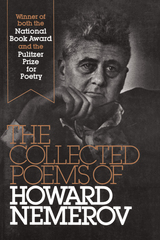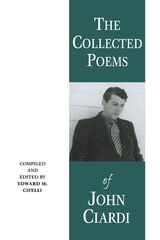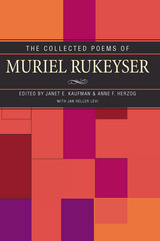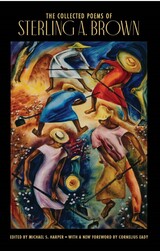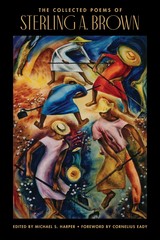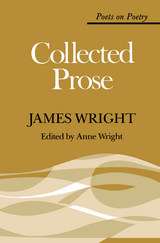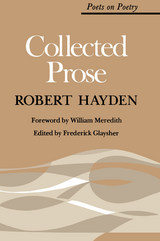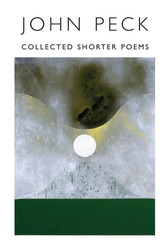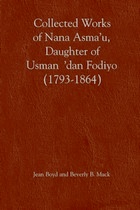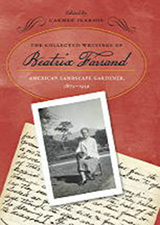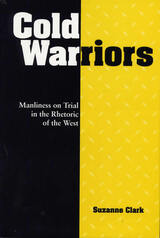 Cold Warriors: Manliness on Trial in the Rhetoric of the West
Suzanne Clark
Southern Illinois University Press, 2000
Cold Warriors: Manliness on Trial in the Rhetoric of the West returns to familiar cultural forces—the West, anticommunism, and manliness—to show how they combined to suppress dissent and dominate the unruliness of literature in the name of a national identity after World War II. Few realize how much the domination of a “white male” American literary canon was a product not of long history, but of the Cold War. Suzanne Clark describes here how the Cold War excluded women writers on several levels, together with others—African American, Native American, poor, men as well as women—who were ignored in the struggle over white male identity.
Clark first shows how defining national/individual/American identity in the Cold War involved a brand new configuration of cultural history. At the same time, it called upon the nostalgia for the old discourses of the West (the national manliness asserted by Theodore Roosevelt) to claim that there was and always had been only one real American identity.
By subverting the claims of a national identity, Clark finds, many male writers risked falling outside the boundaries not only of public rhetoric but also of the literary world: men as different from one another as the determinedly masculine Ernest Hemingway and the antiheroic storyteller of the everyday, Bernard Malamud. Equally vocal and contentious, Cold War women writers were unwilling to be silenced, as Clark demonstrates in her discussion of the work of Mari Sandoz and Ursula Le Guin.
The book concludes with a discussion of how the silencing of gender, race, and class in Cold War writing maintained its discipline until the eruptions of the sixties. By questioning the identity politics of manliness in the Cold War context of persecution and trial, Clark finds that the involvement of men in identity politics set the stage for our subsequent cultural history.
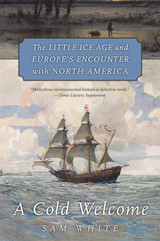 A Cold Welcome: The Little Ice Age and Europe’s Encounter with North America
Sam White
Harvard University Press, 2020 Cundill History Prize Finalist
Longman–History Today Prize Finalist
Winner of the Roland H. Bainton Book Prize
“Meticulous environmental-historical detective work.”
—Times Literary Supplement
When Europeans first arrived in North America, they faced a cold new world. The average global temperature had dropped to lows unseen in millennia. The effects of this climactic upheaval were stark and unpredictable: blizzards and deep freezes, droughts and famines, winters in which everything froze, even the Rio Grande. A Cold Welcome tells the story of this crucial period, taking us from Europe’s earliest expeditions in unfamiliar landscapes to the perilous first winters in Quebec and Jamestown. As we confront our own uncertain future, it offers a powerful reminder of the unexpected risks of an unpredictable climate.
“A remarkable journey through the complex impacts of the Little Ice Age on Colonial North America…This beautifully written, important book leaves us in no doubt that we ignore the chronicle of past climate change at our peril. I found it hard to put down.”
—Brian Fagan, author of The Little Ice Age
“Deeply researched and exciting…His fresh account of the climatic forces shaping the colonization of North America differs significantly from long-standing interpretations of those early calamities.”
—New York Review of Books
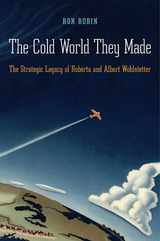 The Cold World They Made: The Strategic Legacy of Roberta and Albert Wohlstetter
Ron Robin
Harvard University Press, 2016 In the heady days of the Cold War, when the Bomb loomed large in the ruminations of Washington’s wise men, policy intellectuals flocked to the home of Albert and Roberta Wohlstetter to discuss deterrence and doomsday. The Cold World They Made takes a fresh look at the original power couple of strategic studies. Seeking to unravel the complex tapestry of the Wohlstetters’ world and worldview, Ron Robin reveals fascinating insights into an unlikely husband-and-wife pair who, at the height of the most dangerous military standoff in history, gained access to the deepest corridors of American power.
The author of such classic Cold War treatises as “The Delicate Balance of Terror,” Albert Wohlstetter is remembered for advocating an aggressive brinksmanship that stood in stark contrast with what he saw as weak and indecisive policies of Soviet containment. Yet Albert’s ideas built crucially on insights gleaned from his wife. Robin makes a strong case for the Wohlstetters as a team of intellectual equals, showing how Roberta’s scholarship was foundational to what became known as the Wohlstetter Doctrine. Together at RAND Corporation, Albert and Roberta crafted a mesmerizing vision of the Soviet threat, theorizing ways for the United States to emerge victorious in a thermonuclear exchange.
Far from dwindling into irrelevance after the Cold War, the torch of the Wohlstetters’ intellectual legacy was kept alive by well-placed disciples in George W. Bush’s administration. Through their ideological heirs, the Wohlstetters’ signature combination of brilliance and hubris continues to shape American policies.
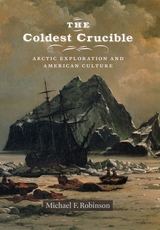 The Coldest Crucible: Arctic Exploration and American Culture
Michael F. Robinson
University of Chicago Press, 2006 In the late 1800s, “Arctic Fever” swept across the nation as dozens of American expeditions sailed north to the Arctic to find a sea route to Asia and, ultimately, to stand at the North Pole. Few of these missions were successful, and many men lost their lives en route. Yet failure did little to dampen the enthusiasm of new explorers or the crowds at home that cheered them on. Arctic exploration, Michael F. Robinson argues, was an activity that unfolded in America as much as it did in the wintry hinterland. Paying particular attention to the perils facing explorers at home, The Coldest Crucible examines their struggles to build support for the expeditions before departure, defend their claims upon their return, and cast themselves as men worthy of the nation’s full attention. In so doing, this book paints a new portrait of polar voyagers, one that removes them from the icy backdrop of the Arctic and sets them within the tempests of American cultural life.
With chronological chapters featuring emblematic Arctic explorers—including Elisha Kent Kane, Charles Hall, and Robert Peary—The Coldest Crucible reveals why the North Pole, a region so geographically removed from Americans, became an iconic destination for discovery.
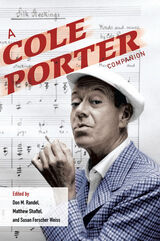 A Cole Porter Companion
Edited by Don M. Randel, Matthew Shaftel, and Susan Forscher
University of Illinois Press, 2016 Balancing sophisticated melodies and irresistible rhythms with lyrics by turns cynical and passionate, Cole Porter sent American song soaring on gossamer wings. Timeless works like "I Get a Kick Out of You" and "At Long Last Love" made him an essential figure in the soundtrack of a century and earned him adoration from generations of music lovers. In A Cole Porter Companion, a parade of performers and scholars offers essays on little-known aspects of the master tunesmith's life and art. Here are Porter's days as a Yale wunderkind and his nights as the exemplar of louche living; the triumph of Kiss Me Kate and shocking failure of You Never Know; and his spinning rhythmic genius and a turkey dinner into "You're the Top" while cultural and economic forces take "Ev'ry Time We Say Goodbye" in unforeseen directions. Other entries explore notes on ongoing Porter scholarship and delve into his formative works, performing career, and long-overlooked contributions to media as varied as film and ballet. Prepared with the cooperation of the Porter archives, A Cole Porter Companion is an invaluable guide for the fans and scholars of this beloved American genius.
Coleridge
Walter Jackson Bate
Harvard University Press, 1987
Collaborate
Mary Catherine Coleman
American Library Association, 2022
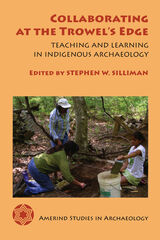 Collaborating at the Trowel's Edge: Teaching and Learning in Indigenous Archaeology
Edited by Stephen W. Silliman
University of Arizona Press, 2008 A fundamental issue for twenty-first century archaeologists is the need to better direct their efforts toward supporting rather than harming indigenous peoples. Collaborative indigenous archaeology has already begun to stress the importance of cooperative, community-based research; this book now offers an up-to-date assessment of how Native American and non-native archaeologists have jointly undertaken research that is not only politically aware and historically minded but fundamentally better as well.
Eighteen contributors—many with tribal ties—cover the current state of collaborative indigenous archaeology in North America to show where the discipline is headed. Continent-wide cases, from the Northeast to the Southwest, demonstrate the situated nature of local practice alongside the global significance of further decolonizing archaeology. And by probing issues of indigenous participation with an eye toward method, theory, and pedagogy, many show how the archaeological field school can be retailored to address politics, ethics, and critical practice alongside traditional teaching and research methods.
These chapters reflect the strong link between politics and research, showing what can be achieved when indigenous values, perspectives, and knowledge are placed at the center of the research process. They not only draw on experiences at specific field schools but also examine advances in indigenous cultural resource management and in training Native American and non-native students.
Theoretically informed and practically grounded, Collaborating at the Trowel’s Edge is a virtual guide for rethinking field schools and is an essential volume for anyone involved in North American archaeology—professionals, students, tribal scholars, or avocationalists—as well as those working with indigenous peoples in other parts of the world. It both reflects the rapidly changing landscape of archaeology and charts new directions to ensure the ongoing vitality of the discipline.
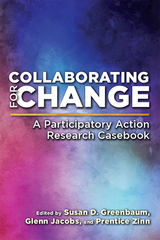 Collaborating for Change: A Participatory Action Research Casebook
Susan D. Greenbaum
Rutgers University Press, 2020 Across the U.S. immigrants, laborers, domestic workers, low-income tenants, indigenous communities, and people experiencing homelessness are conducting research to fight for justice. Collaborating for Change: A Participatory Action Research Casebook documents the stories of a dozen community-based research projects. Academics and their partners share authorship about the importance of gathering credible evidence, both for organizing and persuading. The emphasis is on community organizations involved in struggles for equality and justice. Research projects directly engage community partners in all phases of the research process. Finally, the stories capture how the research changes the roles of researchers and those being researched. The book is designed for students, but also for community organizers, social justice activists, and their research allies; it offers real stories and real projects that show how democratizing research supports social change and heightens our understanding of complex social issues.
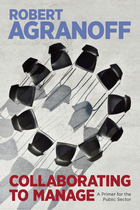 Collaborating to Manage: A Primer for the Public Sector
Robert Agranoff
Georgetown University Press, 2012 Collaborating to Manage captures the basic ideas and approaches to public management in an era where government must partner with external organizations as well as other agencies to work together to solve difficult public problems. In this primer, Robert Agranoff examines current and emergent approaches and techniques in intergovernmental grants and regulation management, purchase-of-service contracting, networking, public/nonprofit partnerships and other lateral arrangements in the context of the changing public agency. As he steers the reader through various ways of coping with such organizational richness, Agranoff offers a deeper look at public management in an era of shared public program responsibility within governance. Geared toward professionals working with the new bureaucracy and for students who will pursue careers in the public or non-profit sectors, Collaborating to Manage is a student-friendly book that contains many examples of real-world practices, lessons from successful cases, and summaries of key principles for collaborative public management.
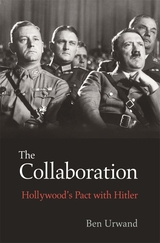 The Collaboration: Hollywood’s Pact with Hitler
Ben Urwand
Harvard University Press, 2013 To continue doing business in Germany after Hitler's ascent to power, Hollywood studios agreed not to make films that attacked the Nazis or condemned Germany's persecution of Jews. Ben Urwand reveals this bargain for the first time—a "collaboration" (Zusammenarbeit) that drew in a cast of characters ranging from notorious German political leaders such as Goebbels to Hollywood icons such as Louis B. Mayer.
At the center of Urwand's story is Hitler himself, who was obsessed with movies and recognized their power to shape public opinion. In December 1930, his Party rioted against the Berlin screening of All Quiet on the Western Front, which led to a chain of unfortunate events and decisions. Fearful of losing access to the German market, all of the Hollywood studios started making concessions to the German government, and when Hitler came to power in January 1933, the studios—many of which were headed by Jews—began dealing with his representatives directly.
Urwand shows that the arrangement remained in place through the 1930s, as Hollywood studios met regularly with the German consul in Los Angeles and changed or canceled movies according to his wishes. Paramount and Fox invested profits made from the German market in German newsreels, while MGM financed the production of German armaments. Painstakingly marshaling previously unexamined archival evidence, The Collaboration raises the curtain on a hidden episode in Hollywood—and American—history.
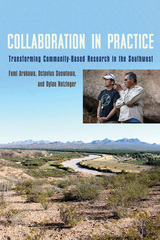 Collaboration in Practice: Transforming Community-Based Research in the Southwest
Fumi Arakawa, Octavius Seowtewa, and Dylan Retzinger
University of Arizona Press, 2026 Focusing on the Chavez Cave collections in Las Cruces, New Mexico, Collaboration in Practice presents a study of the partnership between New Mexico State University and the Zuni Cultural Resource Advisory Team (ZCRAT). Rather than centering on artifact analysis, the authors emphasize the collaborative process itself—visiting the site, curating an exhibition, and co-authoring this volume—as a model for ethical and respectful research.
The book situates this collaboration within the broader historical and political context of archaeology and museology. It critically explores how museums and academic institutions can shift from extractive practices to ones that prioritize Indigenous sovereignty, knowledge systems, and cultural continuity. Through personal narratives, historical context, and methodological insights, the authors highlight the challenges and transformative potential of working collaboratively. They show how true collaboration requires humility, mutual respect, and a commitment to shared authority in both research and representation.
Ultimately, this work charts a path forward for community-based research that centers Indigenous voices and values. It advocates for an archaeology that is not only more inclusive but also more meaningful to the communities whose histories are being studied. A vital resource for scholars, students, and practitioners, this work seeks to engage in ethical, reciprocal, and culturally grounded research in the Southwest and beyond.
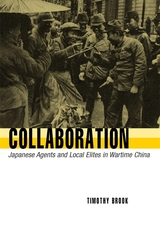 Collaboration: Japanese Agents and Local Elites in Wartime China
Timothy Brook
Harvard University Press, 2005 Studies of collaboration have changed how the history of World War II in Europe is written, but for China and Japan this aspect of wartime conduct has remained largely unacknowledged. In a bold new work, Timothy Brook breaks the silence surrounding the sensitive topic of wartime collaboration between the Chinese and their Japanese occupiers.
Japan's attack on Shanghai in August 1937 led to the occupation of the Yangtze Delta. In spite of the legendary violence of the assault, Chinese elites throughout the delta came forward to work with the conquerors. Using archives on both sides of the conflict, Brook reconstructs the process of collaboration from Shanghai to Nanking. Collaboration proved to be politically unstable and morally awkward for both sides, provoking tensions that undercut the authority of the occupation state and undermined Japan's long-term prospects for occupying China.
This groundbreaking study mirrors the more familiar stories of European collaboration with the Nazis, showing how the Chinese were deeply troubled by their unavoidable cooperation with the occupiers. The comparison provides a point of entry into the difficult but necessary discussion about this long-ignored aspect of the war in the Pacific.
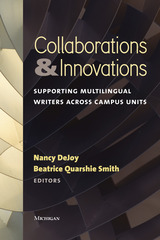 Collaborations & Innovations: Supporting Multilingual Writers across Campus Units
Nancy DeJoy and Beatrice Quarshie Smith
University of Michigan Press, 2017 For decades, U.S. institutions of higher education have discussed ways to meet the needs of multilingual students; the more recent increases in enrollment by international students have created opportunities for productive change across campuses—particularly ways that units can collaborate to better meet those needs.
The chapters in this volume demonstrate that teaching effective communication skills to all students in ways that recognize the needs of multiple language users requires a shift in perspective that approaches multilingualism as an opportunity that is enhanced by the internationalization of higher education because it makes transparent the problems of current structures and disciplinary approaches in accessing those opportunities. A goal of this collection is to address the economic, structural, disciplinary, and pedagogical challenges of making this type of shift in bold and compassionate ways.
Chapters are organized into these four parts--Program-Level Challenges and Opportunities, Opportunities for Enhancing Teacher Training, Multilingualism and the Revision of First-Year Writing, and Integrating Writing Center Insights—and reflect the perspectives of a variety of university language settings. The contributions feature collaborative models and illustrate the need to rethink structures, pedagogies, assessment/evaluation processes, and teacher training for graduate and undergraduate students who will teach writing and other forms of communication.
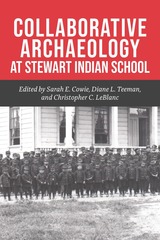 Collaborative Archaeology at Stewart Indian School
Sarah E. Cowie
University of Nevada Press, 2019 Winner of the 2019 Mark E. Mack Community Engagement Award from the Society for Historical Archaeology, the collaborative archaeology project at the former Stewart Indian School documents the archaeology and history of a heritage project at a boarding school for American Indian children in the Western United States. In Collaborative Archaeology at Stewart Indian School, the team’s collective efforts shed light on the children’s education, foodways, entertainment, health, and resilience in the face of the U.S. government’s attempt to forcibly assimilate Native populations at the turn of the twentieth century, as well as school life in later years after reforms.
This edited volume addresses the theory, methods, and outcomes of collaborative archaeology conducted at the Stewart Indian School site and is a genuine collective effort between archaeologists, former students of the school, and other tribal members. With more than twenty contributing authors from the University of Nevada, Reno, Nevada Indian Commission, Washoe Tribal Historic Preservation Office, and members of Washoe, Paiute, and Shoshone tribes, this rich case study is strongly influenced by previous work in collaborative and Indigenous archaeologies. It elaborates on those efforts by applying concepts of governmentality (legal instruments and practices that constrain and enable decisions, in this case, regarding the management of historical populations and modern heritage resources) as well as social capital (valued relations with others, in this case, between Native and non-Native stakeholders).
As told through the trials, errors, shared experiences, sobering memories, and stunning accomplishments of a group of students, archaeologists, and tribal members, this rare gem humanizes archaeological method and theory and bolsters collaborative archaeological research.
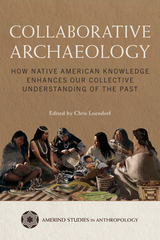 Collaborative Archaeology: How Native American Knowledge Enhances Our Collective Understanding of the Past
Edited by Chris Loendorf
University of Arizona Press, 2026 Collaborative Archaeology brings together a diverse group of scholars and tribal cultural resource professionals to showcase how Indigenous knowledge is transforming archaeological practice. Edited by Chris Loendorf, this volume features twelve case studies that highlight the power of partnership between Native American communities and archaeologists. These collaborations not only enrich our understanding of the past but also affirm Indigenous cultural continuity. From the establishment of Tribal Historic Preservation Offices to tribally led research initiatives, the book illustrates how Native voices are reshaping the field.
This timely collection bridges disciplinary divides between archaeology, history, and traditional knowledge, challenging outdated narratives that separate “prehistory” from living Indigenous communities. Contributors demonstrate how ethical, community-based research can lead to more accurate and respectful interpretations of the past. Collaborative Archaeology is essential reading for scholars, students, and practitioners committed to scientific understanding and cultural preservation. Contributors
Nicole Armstrong-Best
Skylar Begay
Jennifer Bess
Hannah F. Chavez
Robert B. Ciaccio
Shannon Cowell
William H. Doelle
Karl A. Hoerig
Anabel Galindo
Barnaby V. Lewis
Chris Loendorf
Brian Medchill
Linda Morgan
Laurene G. Montero
Stephen E. Nash
Eloise Pedro
Glen E. Rice
Teresa Rodrigues
Hoski Schaafsma
Thomas E. Sheridan
Katrina Soke
Lindsey Vogel-Teeter
Anastasia Walhovd
Kelly Washington
Reylynne Williams
M. Kyle Woodson
Aaron M. Wright
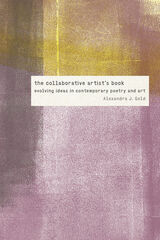 The Collaborative Artist's Book: Evolving Ideas in Contemporary Poetry and Art
Alexandra J. Gold
University of Iowa Press, 2023 35th Modern Language Association Prize for Contingent Faculty and Independent Scholars, Honorable Mention
The Collaborative Artist’s Book offers a rare glimpse into collaborations between poets and painters from 1945 to the present, and highlights how the artist’s book became a critical form for experimental American artists in the twentieth and twenty-first centuries. Alexandra Gold provides a broad overview of the artist’s book form and the many ongoing debates and challenges, from the disciplinary to the institutional, that these forms continue to pose.
Gold presents five case studies and details not only how each individual collaboration came to be but how all five together engage and challenge conventional ideals about art, subjectivity, poetry, and interpersonal relations, as well as complex social questions related to gender and race. Taking several of these books out of special collections libraries and museum archives and making them available to a broad readership, Gold brings to light a whole genre that has been largely forgotten or neglected.
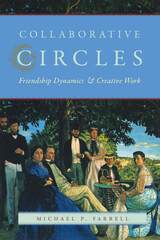 Collaborative Circles: Friendship Dynamics and Creative Work
Michael P. Farrell
University of Chicago Press, 2001 Many artists, writers, and other creative people do their best work when collaborating within a circle of likeminded friends. Experimenting together and challenging one another, they develop the courage to rebel against the established traditions in their field. Out of their discussions they develop a new, shared vision that guides their work even when they work alone.
In a unique study that will become a rich source of ideas for professionals and anyone interested in fostering creative work in the arts and sciences, Michael P. Farrell looks at the group dynamics in six collaborative circles: the French Impressionists; Sigmund Freud and his friends; C. S. Lewis, J. R. R. Tolkien, and the Inklings; social reformers Elizabeth Cady Stanton and Susan B. Anthony; the Fugitive poets; and the writers Joseph Conrad and Ford Maddox Ford. He demonstrates how the unusual interactions in these collaborative circles drew out the creativity in each member. Farrell also presents vivid narrative accounts of the roles played by the members of each circle. He considers how working in such circles sustains the motivation of each member to do creative work; how collaborative circles shape the individual styles of the persons within them; how leadership roles and interpersonal relationships change as circles develop; and why some circles flourish while others flounder.
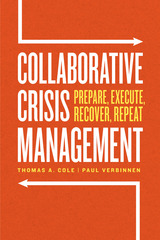 Collaborative Crisis Management: Prepare, Execute, Recover, Repeat
Thomas A. Cole and Paul Verbinnen
University of Chicago Press, 2022 A no-nonsense guide for corporations facing crisis, from two experienced crisis managers
All organizations face crises from time to time, and at a time when news, information (or misinformation), and rumors can spread quickly, a timely and thoughtful response to a crisis, is critical. In this book, two industry insiders offer a primer on how organizational leadership should prepare for and handle crises. The steps, plans, and cautions they offer show how organizations can deal openly and honestly with challenges while continuing to survive and prosper.
Thomas A. Cole and Paul Verbinnen show how successful crisis management requires a multi-disciplined approach enacted collaboratively under strong leadership. Drawing on many real-world examples, they speak to not only what to do during a crisis, but also the need for preparedness and post-crisis follow-up. The book is organized around a broad range of discrete issues that need to be addressed in managing any crisis and provides the steps required to successfully address each of those issues. The authors urge crisis managers to focus attention equally on four phases of management: prepare, execute, recover, and then repeat (after reflecting on the results of the last crisis) with the next one. The emphasis is on preparation and planning, setting up the procedures, and organizing the teams that will respond to each crisis.
Unlike other crisis books that focus solely on communication, Collaborative Crisis Management goes further and in addition to communication, it discusses both the legal obligations and organizational challenges that accompany a crisis. The result is an indispensable guide for leaders, board members, and business students.
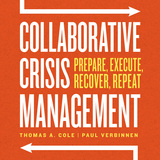 Collaborative Crisis Management: Prepare, Execute, Recover, Repeat
Thomas A. Cole and Paul Verbinnen
University of Chicago Press, 2022 This is the audiobook version of this book.
Two experienced corporate crisis advisors offer a thorough and approachable guide to successful crisis management from anticipation to resolution.
All organizations face crises from time to time, and at a time when news, information (or misinformation), and rumors can spread quickly, a timely and thoughtful response to a crisis, is critical. In this book, two industry insiders offer a primer on how organizational leadership should prepare for and handle crises. The steps, plans, and cautions they offer show how organizations can deal openly and honestly with challenges while continuing to survive and prosper.
Thomas A. Cole and Paul Verbinnen show how successful crisis management requires a multi-disciplined approach enacted collaboratively under strong leadership. Drawing on many real-world examples, they speak to not only what to do during a crisis, but also the need for preparedness and post-crisis follow-up. The book is organized around a broad range of discrete issues that need to be addressed in managing any crisis and provides the steps required to successfully address each of those issues. The authors urge crisis managers to focus attention equally on four phases of management: prepare, execute, recover, and then repeat (after reflecting on the results of the last crisis) with the next one. The emphasis is on preparation and planning, setting up the procedures, and organizing the teams that will respond to each crisis.
Unlike other crisis books that focus solely on communication, Collaborative Crisis Management goes further and in addition to communication, it discusses both the legal obligations and organizational challenges that accompany a crisis. The result is an indispensable guide for leaders, board members, and business students.
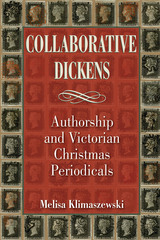 Collaborative Dickens: Authorship and Victorian Christmas Periodicals
Melisa Klimaszewski
Ohio University Press, 2019 From 1850 to 1867, Charles Dickens produced special issues (called “numbers”) of his journals Household Words and All the Year Round, which were released shortly before Christmas each year. In Collaborative Dickens, Melisa Klimaszewski undertakes the first comprehensive study of these Christmas numbers. She argues for a revised understanding of Dickens as an editor who, rather than ceaselessly bullying his contributors, sometimes accommodated contrary views and depended upon multivocal narratives for his own success. Klimaszewski uncovers connections among and between the stories in each Christmas collection. She thus reveals ongoing conversations between the works of Dickens and his collaborators on topics important to the Victorians, including race, empire, supernatural hauntings, marriage, disability, and criminality. Stories from Wilkie Collins, Elizabeth Gaskell, and understudied women writers such as Amelia B. Edwards and Adelaide Anne Procter interact provocatively with Dickens’s writing. By restoring links between stories from as many as nine different writers in a given year, Klimaszewski demonstrates that a respect for the Christmas numbers’ plural authorship and intertextuality results in a new view of the complexities of collaboration in the Victorian periodical press and a new appreciation for some of the most popular texts Dickens published.
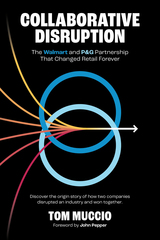 Collaborative Disruption: The Walmart and P&G Partnership That Changed Retail Forever
Tom Muccio
Epic Books, 2024 Collaborative Disruption is an insider’s account of the relationship between two of the most successful companies on the planet—Walmart and Procter & Gamble—and the transformative impact their collaborative strategy has had on their business for more than thirty years, particularly in the retail industry. Their innovative partnership produced what has come to be known as the “one-company model,” an approach that has fundamentally changed how suppliers and their retail customers interact with each other. Tom Muccio, who led the team at P&G that innovated this concept with Walmart, outlines how the two firms broke through silos, self-interest, short-termism, and suspiciousness to forge a mutually beneficial partnership focused on trust, shared information, and transparency. A masterclass in this model of collaboration that has been key to the success of several of the biggest companies around the world, Collaborative Disruption at its heart is a book about change management and vision.
 Collaborative Governance Regimes
Kirk Emerson and Tina Nabatchi
Georgetown University Press, 2015 Whether the goal is building a local park or developing disaster response models, collaborative governance is changing the way public agencies at the local, regional, and national levels are working with each other and with key partners in the nonprofit and private sectors. While the academic literature has spawned numerous case studies and context- or policy-specific models for collaboration, the growth of these innovative collaborative governance systems has outpaced the scholarship needed to define it. Collaborative Governance Regimes breaks new conceptual and practical ground by presenting an integrative framework for working across boundaries to solve shared problems, a typology for understanding variations among collaborative governance regimes, and an approach for assessing both process and productivity performance. This book draws on diverse literatures and uses rich case illustrations to inform scholars and practitioners about collaborative governance regimes and to provide guidance for designing, managing, and studying such endeavors in the future. Collaborative Governance Regimes will be of special interest to scholars and researchers in public administration, public policy, and political science who want a framework for theory building, yet the book is also accessible enough for students and practitioners.
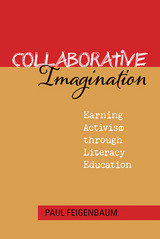 Collaborative Imagination: Earning Activism through Literacy Education
Paul Feigenbaum
Southern Illinois University Press, 2015 Processes of fighting unequal citizenship have historically prioritized literacy education, through which people envision universal first-class citizenship and devise practical methods for enacting this vision. In this important volume, literacy scholar Paul Feigenbaum explores how literacy education can facilitate activism in contemporary contexts in which underserved populations often remain consigned to second-class status despite official guarantees of equal citizenship. By conceiving of education as, in part, a process of understanding and grappling with adaptive and activist rhetorics, Feigenbaum explains, educators can direct people’s imaginations toward activism without running up against the conceptual problems so many scholars associate with critical pedagogy. Over time, this model of education expands people’s imaginations about what it means to be a good citizen, facilitates increased civic participation, and encourages collective destabilization of, rather than adaptation to, the structural inequalities of mainstream civic institutions. Feigenbaum offers detailed analyses of various locations and time periods inside, outside, and across the walls of formal education, including the Citizenship Schools and Freedom Schools rooted in the Civil Rights Movement of the 1950s and 1960s; the Algebra Project, a current practical-literacy network; and the Imagination Federation, a South Florida–based Earth-Literacy network. Considering both the history and the future of community literacy, Collaborative Imagination offers educators a powerful mechanism for promoting activism through their teaching and scholarship, while providing practical ideas for greater civic engagement among students.
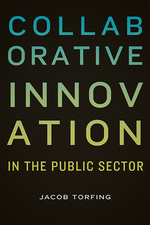 Collaborative Innovation in the Public Sector
Jacob Torfing
Georgetown University Press, 2016 Governments worldwide struggle to remove policy deadlocks and enact much-needed reforms in organizational structure and public services. In this book, Jacob Torfing explores collaborative innovation as a way for public and private stakeholders to break the impasse. These network-based collaborations promise to multiply the skills, ideas, energy, and resources between government and its partners across agency boundaries and in the nonprofit and private sectors. Torfing draws on his own pioneering work in Europe as well as examples from the United States and Australia to construct a cross-disciplinary framework for studying collaborative innovation. His analysis explores its complex and interactive processes as he looks at how drivers and barriers may enhance or impede the collaborative approach. He also reflects on the roles institutional design, public management, and governance reform play in spurring collaboration for public sector innovation. The result is a theoretically and empirically informed book that carefully demonstrates how multi-actor collaboration can enhance public innovation in the face of fiscal constraint, the proliferation of wicked problems, and the presence of unsatisfied social needs.
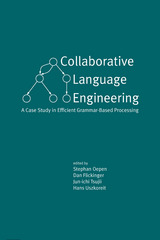 Collaborative Language Engineering: A Case Study in Efficient Grammar-Based Processing
Edited by Stephan Oepen, Dan Flickinger, Jun-ichi Tsujii, and Hans Uszkoreit
CSLI, 2001 Following high hopes and subsequent disillusionment in the late 1980s, the past decade of work in language engineering has seen a dramatic increase in the power and sophistication of statistical approaches to natural language processing, along with a growing recognition that these methods alone cannot meet the full range of demands for applications of NLP. While statistical methods, often described as 'shallow' processing techniques, can bring real advantages in robustness and efficiency, they do not provide the precise, reliable representations of meaning which more conventional symbolic grammars can supply for natural language. A consistent, fine-grained mapping between form and meaning is of critical importance in some NLP applications, including machine translation, speech prosthesis, and automated email response. Recent advances in grammar development and processing implementations offer hope of meeting these demands for precision.
This volume provides an update on the state of the art in the development and application of broad-coverage declarative grammars built on sound linguistic foundations - the 'deep' processing paradigm - and presents several aspects of an international research effort to produce comprehensive, re-usable grammars and efficient technology for parsing and generating with such grammars.
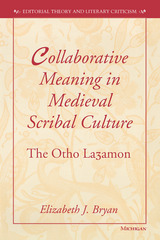 Collaborative Meaning in Medieval Scribal Culture: The Otho La3amon
Elizabeth J. Bryan
University of Michigan Press, 1999 Before the technology of print, every book was unique. Two manuscripts of the "same" text could package and transmit that text very differently, depending on the choices made by scribes, compilers, translators, annotators, and decorators. Is it appropriate, Elizabeth Bryan asks, for us to read these books as products of a single author's consciousness? And if not, how do we read them?
In Collaborative Meaning in Medieval Scribal Culture, Bryan compares examples from the British Library Cotton Otho C.xiii manuscript of La3amon's Brut, the early thirteenth-century verse history that translated King Arthur into English for the first time. She discovers cultural attitudes that valued communal aspects of manuscript texts--for example, a view of the physical book as connecting all who read or even held it to each other.
The study is divided into two parts. Part one presents Early Middle English concepts of "enjoining" texts and explores the theoretical and methodological challenges they pose to present-day readers of scribally-produced texts. Part two conducts a detailed study of the multiple interpretations built into the manuscript text. Illustrations of manuscript pages accompany analysis, and the reader is invited to engage in interpreting the manuscript text.
Collaborative Meaning in Medieval Scribal Culture will be of interest to students and specialists in medieval chronicle histories, Middle English, Arthurian literature, and literary and textual theory.
Elizabeth J. Bryan is Associate Professor of English, Brown University.
Collaborative Planning for Wetlands and Wildlife: Issues And Examples
Edited by Douglas R. Porter and David A. Salvesen; Foreword by John De Grove
Island Press, 1995 Collaborative Planning for Wetlands and Wildlife presents numerous case studies that demonstrate how different communities have creatively reconciled problems between developers and environmentalists. It answers questions asked by regulators, environmentalists, and developers who seek practical alternatives to the existing case-by-case permitting process, and offers valuable lessons from past and ongoing areawide planning efforts.
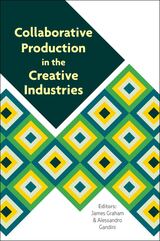 Collaborative Production in the Creative Industries
James Graham and Alessandro Gandini
University of Westminster Press, 2017 In recent years research into creative labour and cultural work has usually addressed the politics of production in these fields, but the sociotechnical and aesthetic dimensions of collaborative creative work have been somewhat overlooked. This book aims to address this gap. Through case studies that range from TV showrunning to independent publishing, from the film industry to social media platforms such as Tumblr and Wattpad, this collection develops a critical understanding of the integral role collaboration plays in contemporary media and culture. It draws attention to diverse kinds of creative collaboration afforded via the intermediation of digital platforms and networked publics. It considers how these are incorporated into emergent market paradigms and investigates the complicated forms of subjectivity that develop as a consequence. But it also acknowledges historical continuities, not least in terms of the continued exploitation of ‘support personnel’ and of resulting artistic conflicts but also of alternative models that resist the precarious nature of contemporary cultural work. Finally, this volume attempts to situate creative collaboration in broader social and economic contexts, where the experience and outcomes of such work have proved more problematic than the rich potential of their promise would lead us to expect. The Editors: James Graham is Senior Lecturer in the Faculty of Arts and Creative Industries, Middlesex University, London. Alessandro Gandini is Lecturer in Digital Media Management and Innovation in the Department of Digital Humanities, Kings College, London.
 Collaborative Public Management: New Strategies for Local Governments
Robert Agranoff and Michael McGuire
Georgetown University Press Local governments do not stand alone—they find themselves in new relationships not only with state and federal government, but often with a widening spectrum of other public and private organizations as well. The result of this re-forming of local governments calls for new collaborations and managerial responses that occur in addition to governmental and bureaucratic processes-as-usual, bringing locally generated strategies or what the authors call "jurisdiction-based management" into play. Based on an extensive study of 237 cities within five states, Collaborative Public Management provides an in-depth look at how city officials work with other governments and organizations to develop their city economies and what makes these collaborations work. Exploring the more complex nature of collaboration across jurisdictions, governments, and sectors, Agranoff and McGuire illustrate how public managers address complex problems through strategic partnerships, networks, contractual relationships, alliances, committees, coalitions, consortia, and councils as they function together to meet public demands through other government agencies, nonprofit associations, for-profit entities, and many other types of nongovernmental organizations. Beyond the "how" and "why," Collaborative Public Management identifies the importance of different managerial approaches by breaking them down into parts and sequences, and describing the many kinds of collaborative activities and processes that allow local governments to function in new ways to address the most nettlesome public challenges.
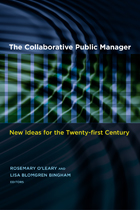 The Collaborative Public Manager: New Ideas for the Twenty-First Century
Rosemary O’Leary and Lisa Blomgren Bingham, Editors
Georgetown University Press, 2009 Today’s public managers not only have to function as leaders within their agencies, they must also establish and coordinate multi-organizational networks of other public agencies, private contractors, and the public. This important transformation has been the subject of an explosion of research in recent years.
The Collaborative Public Manager brings together original contributions by some of today’s top public management and public policy scholars who address cutting-edge issues that affect government managers worldwide. State-of-the-art empirical research reveals why and how public managers collaborate and how they motivate others to do the same. Examining tough issues such as organizational design and performance, resource sharing, and contracting, the contributors draw lessons from real-life situations as they provide tools to meet the challenges of managing conflict within interorganizational, interpersonal networks.
This book pushes scholars, students, and professionals to rethink what they know about collaborative public management—and to strive harder to achieve its full potential.
 Collaborative Research in the Datafied Society: Methods and Practices for Investigation and Intervention
Mirko Tobias Schäfer
Amsterdam University Press, 2024 The influence of austerity measures and neoliberal ideologies has sparked discussions about the relevance and value of academic institutions, particularly in the humanities and social sciences. Universities are redirecting academic focus towards greater societal engagement. This book argues that academia has much to gain by moving beyond its institutional walls, in our case, by doing data work with stakeholders and civil society. This collaborative work benefits citizens in our democratic, open societies and advances our knowledge economies.
Collaborative Research in the Datafied Society offers a combination of theoretical insights, practical methodologies, and case studies, showcasing the power of collaborative research with stakeholders across diverse communities and civil society to tackle challenges that address pressing issues stemming from data practices and social justice issues. Taken together, the book’s chapters formulate relevant concepts for grounding societally engaged research in the theories and methodologies from different disciplines. In addition, the book informs university administrators and research directors how to advance academia effectively towards mutual knowledge transfer with societal sectors.
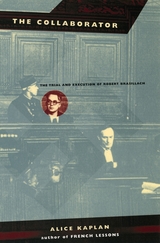 The Collaborator: The Trial and Execution of Robert Brasillach
Alice Kaplan
University of Chicago Press, 2000 On February 6, 1945, Robert Brasillach was executed for treason by a French firing squad. He was a writer of some distinction—a prolific novelist and a keen literary critic. He was also a dedicated anti-Semite, an acerbic opponent of French democracy, and editor in chief of the fascist weekly Je Suis Partout, in whose pages he regularly printed wartime denunciations of Jews and resistance activists.
Was Brasillach in fact guilty of treason? Was he condemned for his denunciations of the resistance, or singled out as a suspected homosexual? Was it right that he was executed when others, who were directly responsible for the murder of thousands, were set free? Kaplan's meticulous reconstruction of Brasillach's life and trial skirts none of these ethical subtleties: a detective story, a cautionary tale, and a meditation on the disturbing workings of justice and memory, The Collaborator will stand as the definitive account of Brasillach's crime and punishment.
A National Book Award Finalist
A National Book Critics Circle Award Finalist
"A well-researched and vivid account."—John Weightman, New York Review of Books
"A gripping reconstruction of [Brasillach's] trial."—The New Yorker
"Readers of this disturbing book will want to find moral touchstones of their own. They're going to need them. This is one of the few works on Nazism that forces us to experience how complex the situation really was, and answers won't come easily."—Daniel Blue, San Francisco Chronicle Book Review
"The Collaborator is one of the best-written, most absorbing pieces of literary history in years."—David A. Bell, New York Times Book Review
"Alice Kaplan's clear-headed study of the case of Robert Brasillach in France has a good deal of current-day relevance. . . . Kaplan's fine book . . . shows that the passage of time illuminates different understandings, and she leaves it to us to reflect on which understanding is better."—Richard Bernstein, The New York Times
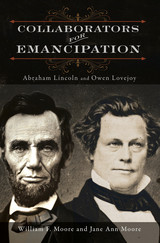 Collaborators for Emancipation: Abraham Lincoln and Owen Lovejoy
William F. Moore and Jane Ann Moore
University of Illinois Press, 2019 Few expected politician Abraham Lincoln and Congregational minister Owen Lovejoy to be friends when they met in 1854. One was a cautious lawyer who deplored abolitionists' flouting of the law, the other an outspoken antislavery activist who captained a stop on the Underground Railroad. Yet the two built a relationship that, in Lincoln's words, "was one of increasing respect and esteem."
In Collaborators for Emancipation: Abraham Lincoln and Owen Lovejoy, the authors examine the thorny issue of the pragmatism typically ascribed to Lincoln versus the radicalism of Lovejoy, and the role each played in ending slavery. Exploring the men's politics, personal traits, and religious convictions, the book traces their separate paths in life as well as their frequent interactions. Collaborators for Emancipation shows how Lincoln and Lovejoy influenced one another and analyzes the strategies and systems of belief each brought to the epic controversies of slavery versus abolition and union versus disunion.
Moore and Moore, editors of a previous volume of Lovejoy's writings, use their deep knowledge of his words and life to move beyond mere politics to a nuanced perspective on the fabric of religion and personal background that underlay the minister's worldview. Their multifaceted work of history and biography reveals how Lincoln embraced the radical idea of emancipation, and how Lovejoy shaped his own radicalism to wield the pragmatic political tools needed to reach that ultimate goal.
 Collages
Anaïs Nin
Ohio University Press, 1964
“Collages began with an image which had haunted me. A friend, Renate, had told me about her trip to Vienna where she was born, and of her childhood relationships to statues. She told me stories of her childhood, her relationship to her father, her first love.
I begin the novel with:
Vienna was the city of statues. They were as numerous as the people who walked the streets. They stood on the top of the highest towers, law down on stone tombs, sat on horseback, kneeled, prayed, fought animals and wars, danced, drank wine and read books made of stone. They adorned cornices like the figureheads of old ships. They stood in the heart of fountains glistening with water as if they had just been born. They sat under the trees in the parks summer and winter. Some wore costumes of other periods, and some no clothes at all. Men, women, children, kings, dwarfs, gargoyles, unicorns, lions, clowns, heroes, wise men, prophets, angels, saints, and soldiers preserved for Vienna a vision of eternity.
As a child Renate could see them from her bedroom window. At night, when the white muslin curtains fluttered out like ballooning wedding dresses, she heard them whispering like figures which had been petrified by a spell during the day and came alive only at night. Their silence by day taught her to read their frozen lips as one reads the messages of deaf mutes. On rainy days their granite eye sockets shed tears mixed with soot.
Renate would never allow anyone to tell her the history of the statues, or to identify them. This would have situated them in the past. She was convinced that people did not die, they became statues. They were people under a spell and if she were watchful enough they would tell her who they were and how they lived now.
If I had been asked then what was going to follow the description of the statues, I could not have answered. I was fascinated by the image of these many statues and of the child Renate inventing stories about them and dialoguing with them. It may have been that this image expressed the feeling I often had that people appear to us as a one-dimensional statue until we go deeper into their life story. People are like mute statues under a spell of appearance, and static, until we let them whisper their secrets. And this only happens at night. That is, when we are able to dream, imagine, and explore the unconscious. We see the external self. Because Collages took its images from painting and sculpture, I liked the idea that sculpture and painting could become animated, speaking, confessing, and then in daylight returning to their previous forms as statues or paintings. They spoke only to the artist. To me it meant dramatizing our relation to art, one feeding the other, the interrelation between human beings and the artist’s conception of them. In daylight (consciousness) we catch them all only in one attitude, one form. At night, we discover their lives.”
—Anaïs Nin, “The Novel of the Future,” (Athens: Ohio University Press, 1986), 128
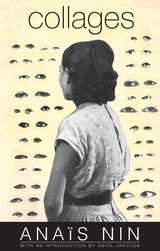 Collages
Anaïs Nin
Ohio University Press, 2019 A transplant from Vienna to Malibu who is driven by her urge to observe and depict those around her, Renate is, as one of her friends describes her, “the freest woman I know.” Living in Malibu, working at the Paradise Inn restaurant, she encounters a series of people whose stories make up a larger collage: Henri the chef; Count Laundromat; Varda the artist and his teenage daughter, Nobuko the actress; the French Consul in the Hollywood Hills; an aged lifeguard with a spiritual longing for the sea; and Bruce, the intimate with an unnerving secret. First published in 1964 and now reissued with a new introduction by Anita Jarczok, Collages showcases Anaïs Nin’s dreamlike and introspective style and psychological acuity. Seen by some as linked vignettes and by others as a novel, the book is a mood piece that resists categorization. Based on a close friend of Nin’s, Renate is the glue that holds the pieces, by turn fragmentary and full, together. One character absorbs a lesson from the Koran: “Nothing is ever finished.” With each of Renate’s successive encounters, we take that message to be true.
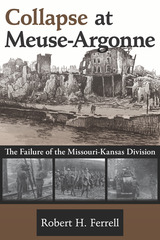 Collapse at Meuse-Argonne: The Failure of the Missouri-Kansas Division
Robert H. Ferrell
University of Missouri Press, 2004 During World War I, the Thirty-fifth Division was made up of National Guard units from Missouri and Kansas. Composed of thousands of men from the two states, the Missouri-Kansas Division entered the great battle of the Meuse-Argonne with no battle experience and only a small amount of training, a few weeks of garrisoning in a quiet sector in Alsace. The division fell apart in five days, and the question Robert Ferrell attempts to answer is why. The Thirty-fifth Division was based at Camp Doniphan on the Fort Sill reservation in Oklahoma and was trained essentially for stationary, or trench, warfare. In March 1918, the German army launched a series of offensives that nearly turned the tide on the Western Front. The tactics were those of open warfare, quick penetrations by massive forces, backed by heavy artillery and machine guns. The American Expeditionary Forces (AEF) commanded by Gen. John J. Pershing were unprepared for this change in tactics. When the Thirty-fifth Division was placed in the opening attack in the Meuse-Argonne on September 26, 1918, it quickly fell. In addition to the Thirty-fifth Division’s lack of experience, its problems were compounded by the necessary confusions of turning National Guard units into a modern assemblage of men and machines. Although the U.S. Army utilized observers during the initial years of World War I, their dispatches had piled up in the War College offices in Washington and, unfortunately, were never studied. The Thirty-fifth Division was also under the command of an incompetent major general and an incompetent artillery brigadier. The result was a debacle in five days, with the division line pushed backward and held only by the 110th Engineer Regiment of twelve hundred men, bolstered by what retreating men could be shoved into the line, some of them at gunpoint. Although three divisions got into trouble at the outset of the Meuse-Argonne, the Thirty-fifth’s failure was the worst. After the collapse, the Red Cross representative of the division, Henry J. Allen, became governor of Kansas and instigated investigations by both houses of Congress. Secretary of War Newton D. Baker testified in an effort to limit the political damage. But the hullabaloo gradually died down, and the whole sad episode passed into the darker corridors of history. By focusing on a single event in history, Collapse at Meuse-Argonne offers a unique glimpse into one of the most critical battles of World War I. Historians, as well as the general reader, will find this new perspective on what really happened to the Thirty-fifth Division fascinating.
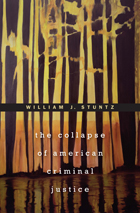 The Collapse of American Criminal Justice
William J. Stuntz
Harvard University Press, 2011 The rule of law has vanished in America’s criminal justice system. Prosecutors now decide whom to punish and how severely. Almost no one accused of a crime will ever face a jury. Inconsistent policing, rampant plea bargaining, overcrowded courtrooms, and ever more draconian sentencing have produced a gigantic prison population, with black citizens the primary defendants and victims of crime. In this passionately argued book, the leading criminal law scholar of his generation looks to history for the roots of these problems—and for their solutions.
The Collapse of American Criminal Justice takes us deep into the dramatic history of American crime—bar fights in nineteenth-century Chicago, New Orleans bordellos, Prohibition, and decades of murderous lynching. Digging into these crimes and the strategies that attempted to control them, Stuntz reveals the costs of abandoning local democratic control. The system has become more centralized, with state legislators and federal judges given increasing power. The liberal Warren Supreme Court’s emphasis on procedures, not equity, joined hands with conservative insistence on severe punishment to create a system that is both harsh and ineffective.
What would get us out of this Kafkaesque world? More trials with local juries; laws that accurately define what prosecutors seek to punish; and an equal protection guarantee like the one that died in the 1870s, to make prosecution and punishment less discriminatory. Above all, Stuntz eloquently argues, Americans need to remember again that criminal punishment is a necessary but terrible tool, to use effectively, and sparingly.
The Collapse of Ancient States and Civilizations
Edited by Norman Yoffee and George L. Cowgill
University of Arizona Press, 1988 This is an excellent collection of essays on the collapse of ancient states and civilizations by historians, archaeologists. . . . excellent overviews of the relevant research.—Contemporary Sociology
 The Collapse of Heaven: The Taiping Civil War and Chinese Literature and Culture, 1850–1880
Huan Jin
Harvard University Press, 2024 The Collapse of Heaven investigates a long-neglected century in Chinese literature through the lens of the Taiping War (1851–1864), one of the most devastating civil wars in human history. With the war as the pivot, Huan Jin examines the manifold literary and cultural transformations that occurred from the 1850s to the 1880s. The book analyzes a wide range of writings—proselytizing pamphlets, diaries, poetry, a full-length novel, drama, and short stories—with a particular emphasis on the materiality of these texts as well as their production and dissemination. Tracing allusions to political turbulences across many genres, Jin discusses how late imperial Chinese literary and cultural paradigms began to unravel under conditions of extreme violence and tracks the unexpected reinventions of literary conventions that marked the beginning of Chinese literary modernity. In addition to making a significant contribution to Chinese studies, this book offers an important comparative perspective on the global nineteenth century and engages with broad scholarly discussions on religion, violence, narrative, history, gender, theater, and media studies.
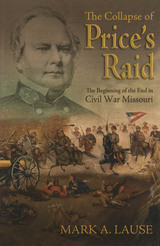 The Collapse of Price's Raid: The Beginning of the End in Civil War Missouri
Mark A. Lause
University of Missouri Press, 2025 As the Civil War was drawing to a close, former Missouri governor Sterling Price led his army on one last desperate campaign to retake his home state for the Confederacy, part of a broader effort to tilt the upcoming 1864 Union elections against Abraham Lincoln and the Republicans. In The Collapse of Price’s Raid: The Beginning of the End in Civil War Missouri, Mark A. Lause examines the complex political and social context of what became known as “Price’s Raid,” the final significant Southern operation west of the Mississippi River. The success of the Confederates would be measured by how long they could avoid returning south to spend a hungry winter among the picked-over fields of southwestern Arkansas and northeastern Texas. As Price moved from Pilot Knob to Boonville, the Raid brutalized and alienated the people it supposedly wished to liberate. With Union cavalry pushing out of Jefferson City, the Confederates took Boonville, Glasgow, and Sedalia in their stride, and fostered a wave of attacks across northern Missouri by guerrillas and organizations of new recruits. With the Missouri River to their north and the ravaged farmlands to their south, Price’s men continued west. At Lexington, Confederates began encountering a second Federal army newly raised in Kansas under General Samuel R. Curtis. A running battle from the Little Blue through Independence to the Big Blue marked the first of three days of battle in the area of Kansas City, as the two Federal armies squeezed the Confederate forces between them. Despite a self-congratulatory victory, Union forces failed to capture the very vulnerable army of Price, which escaped down the Kansas line. The follow-up to Price’s Lost Campaign: The 1864 Invasion of Missouri, Lause’s The Collapse of Price’s Raid is a must-have for any reader interested in the Civil War or in Missouri state history.
 The Collapse of the Fact/Value Dichotomy and Other Essays
Hilary Putnam
Harvard University Press, 2004 If philosophy has any business in the world, it is the clarification of our thinking and the clearing away of ideas that cloud the mind. In this book, one of the world's preeminent philosophers takes issue with an idea that has found an all-too-prominent place in popular culture and philosophical thought: the idea that while factual claims can be rationally established or refuted, claims about value are wholly subjective, not capable of being rationally argued for or against. Although it is on occasion important and useful to distinguish between factual claims and value judgments, the distinction becomes, Hilary Putnam argues, positively harmful when identified with a dichotomy between the objective and the purely "subjective."
Putnam explores the arguments that led so much of the analytic philosophy of language, metaphysics, and epistemology to become openly hostile to the idea that talk of value and human flourishing can be right or wrong, rational or irrational; and by which, following philosophy, social sciences such as economics have fallen victim to the bankrupt metaphysics of Logical Positivism. Tracing the problem back to Hume's conception of a "matter of fact" as well as to Kant's distinction between "analytic" and "synthetic" judgments, Putnam identifies a path forward in the work of Amartya Sen. Lively, concise, and wise, his book prepares the way for a renewed mutual fruition of philosophy and the social sciences.
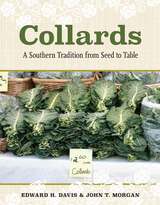 Collards: A Southern Tradition from Seed to Table
Edward H. Davis and John T. Morgan
University of Alabama Press, 2015 Food is essential to southern culture, and collard greens play a central role in the South’s culinary traditions. A feast to the famished, a reward to the strong, and a comfort to the weary, collards have long been held dear in the food-loving southern heart. In Collards: A Southern Tradition from Seed to Table, Edward H. Davis and John T. Morgan provide this emblematic and beloved vegetable the full-length survey its fascinating and complex history merits.
The book begins with collards’ obscure origins. Like a good detective story, the search for collards’ home country leads the authors both to Europe and West Africa, where they unravel a tale as surprising and complex as that of southern people themselves. Crossing back over the Atlantic, the authors traverse miles of American back roads, from Arkansas to Florida and from Virginia to Louisiana. They vividly recount visits to homes, gardens, grocers, farms, and restaurants where the many varieties of collards are honored, from the familiar green collards to the yellow cabbage collard and rare purple cultivars.
In uncovering the secrets of growing collards, the authors locate prize-winning patches of the plant, interview “seed savers,” and provide useful tips for kitchen gardeners. They also describe how collards made the leap from kitchen garden staple to highly valued commercial crop.
Collards captures the tastes, smells, and prize-winning recipes from the South’s premier collards festivals. They find collards at the homes of farmers, jazz musicians, governors, and steel workers. Kin to cabbage and broccoli but superior to both in nutritional value, collard greens transcend human divisions of black and white, rich and poor, sophisticated and rustic, and urban and rural.
Food trends may come and go, but collards are a tradition that southerners return to again and again. Richly illustrated in color, Collards demonstrates the abiding centrality of this green leafy vegetable to the foodways of the American South. In it, readers will rediscover an old friend.
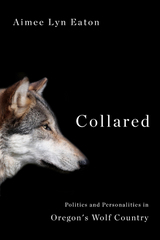 Collared: Politics and Personalities in Oregon's Wolf Country
Aimee Lyn Eaton
Oregon State University Press, 2013 “Just as the humans involved in the wolf debate deserve to be seen as individuals, not stereotypes, so do the wolves. They are not the boogeyman, or storybook monsters aiming to prey upon the young and old. They aren’t cuddly pets or religious icons. They are Canis lupus. Wolves.” —from the Introduction
Teeming with the tension and passion that accompany one of North America’s most controversial apex predators, Collared tracks the events that unfolded when wolves from the reintroduced population of the northern Rocky Mountains dispersed west across state lines into Oregon.
In a forthright and personal style, Aimee Lyn Eaton takes readers from meeting rooms in the state capitol to ranching communities in the rural northeast corner of the state. Using on-the-ground inquiry, field interviews, and in-depth research, she shares the story of how wolves returned to Oregon and the repercussions of their presence in the state.
Collared: Politics and Personalities in Oregon’s Wolf Country introduces readers to the biologists, ranchers, conservationists, state employees, and lawyers on the front lines, encouraging a deeper, multifaceted understanding of the controversial and storied presence of wolves in Oregon.
 Collateral Afterworlds: Sociality Besides Redemption
Zoë H. Wool and Julie Livingston, special issue editors
Duke University Press, 2017 This issue moves beyond the binary of life and death to explore how the gray areas in between—precarious life, slow death—call into question assumptions about the social in social theory. In these “collateral afterworlds,” where the line between life and death is blurred, the presumed attachments of sociality to life and solitude to death are no longer reliable. The contributors focus on the daily experiences of enduring a difficult present unhinged from any redeeming future, addressing topics such as drug treatment centers in Mexico City, solitary death in Japan, Inuit colonial violence, human regard for animal life in India, and intimacies forged between grievously wounded soldiers. Engaging history, film, ethics, and poetics, the contributors explore the modes of intimacy, obligation, and ethical investment that arise in these spaces.
Contributors. Anne Alison, Naisargi N. Dave, Angela Garcia, Fady Joudah, Julie Livingston, Elizabeth A. Povinelli, Solmaz Sharif, Lisa Stevenson, Zoë H. Wool
Collateral Damage: The Influence of Political Rhetoric on the Incorporation of Second-Generation Americans
Sean Richey
University of Michigan Press, 2023 Collateral Damage provides an overview of how political communication influences the process of incorporation with the broad society as well as its political parties. Sean Richey shows that how politicians talk about immigrants affects how their children perceive America and their feelings about the nation. These perceptions and feelings in turn greatly influence the children’s desire to incorporate into American political society. He also shows that regardless of a speaker’s intended outcome, what is said can still have a deleterious effect on incorporation desire, a communicative process that he terms “collateral damage.” Richey uses new experimental and survey evidence, as well as the rhetoric of Donald Trump as a test case, to examine how anti-immigration communication influences the incorporation of the children of immigrants.
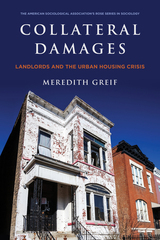 Collateral Damages: Landlords and the Urban Housing Crisis
Meredith Greif
Russell Sage Foundation, 2022 Changes in federal housing policies over the past several decades shifted the primary responsibility for providing low-income renters with affordable housing from the government to private landlords. Federal, state, and local governments have passed laws to ensure that low-income renters are protected from illicit landlording practices. Yet we know little about how private landlords experience local housing regulations. In Collateral Damages, sociologist Meredith Greif examines how local laws affect private landlords and whether tenants are, in fact, being adequately protected.
For three years, Greif followed sixty private landlords serving low- and moderate-income residents in the Cleveland, Ohio, metropolitan area to better understand how local regulations, such as criminal activity nuisance ordinances (CANOs) and local water billing regulations, affect their landlording practices. CANOs are intended to protect communities by discouraging criminal activity on private properties. Property owners can face financial and criminal sanctions if they do not abate nuisance activities, which can include littering, noise, drug use, and calls for police assistance, including calls for domestic violence. Local water billing regulations hold landlords responsible for delinquent water bills, even in cases where the account is registered in the tenant’s name. Greif finds that such laws often increase landlords’ sense of “financial precarity” – the real or perceived uncertainty that their business is financially unsustainable – by holding them responsible for behavior they feel is out of their control. Feelings of financial uncertainty led some landlords to use illegitimate business practices against their tenants, including harassment, oversurveillance, poor property upkeep, and illegal evictions. And to avoid to financial penalties associated with CANOs and delinquent water bills, some landlords engage in discriminatory screening of vulnerable potential tenants who are unemployed or have histories of domestic violence or drug use. In this sense, by promoting a sense of financial insecurity among landlords, laws meant to protect renters ultimately had the opposite effect.
While some landlords, particularly those who rented a larger number of units, were able to operate their businesses both lawfully and profitably, the majority could not. Greif offers practical recommendations to address the concerns of small- and mid-sized landlords, such as regular meetings that bring landlords and local authorities together to engage in constructive dialogue about local housing policy, issues, and concerns. She also proposes policy recommendations to protect renters, such as establishing the right to counsel for lower-income tenants in eviction hearings and enacting a federal renter’s tax credit.
Collateral Damages is an enlightening investigation on how local laws and practices perpetuate disadvantage among marginalized populations and communities, in ways that are hidden and often unintended.
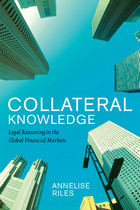 Collateral Knowledge: Legal Reasoning in the Global Financial Markets
Annelise Riles
University of Chicago Press, 2011 Who are the agents of financial regulation? Is good (or bad) financial governance merely the work of legislators and regulators? Here Annelise Riles argues that financial governance is made not just through top-down laws and policies but also through the daily use of mundane legal techniques such as collateral by a variety of secondary agents, from legal technicians and retail investors to financiers and academics and even computerized trading programs.
Drawing upon her ten years of ethnographic fieldwork in the Japanese derivatives market, Riles explores the uses of collateral in the financial markets as a regulatory device for stabilizing market transactions. How collateral operates, Riles suggests, is paradigmatic of a class of low-profile, mundane, but indispensable activities and practices that are all too often ignored as we think about how markets should work and be governed. Riles seeks to democratize our understanding of legal techniques, and demonstrate how these day-to-day private actions can be reformed to produce more effective forms of market regulation.
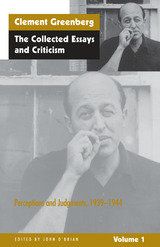 The Collected Essays and Criticism, Volume 1: Perceptions and Judgments, 1939-1944
Clement Greenberg
University of Chicago Press, 1988 Clement Greenberg (1909–1994), champion of abstract expressionism and modernism—of Pollock, Miró, and Matisse—has been esteemed by many as the greatest art critic of the second half of the twentieth century, and possibly the greatest art critic of all time. On radio and in print, Greenberg was the voice of "the new American painting," and a central figure in the postwar cultural history of the United States.
Greenberg first established his reputation writing for the Partisan Review, which he joined as an editor in 1940. He became art critic for the Nation in 1942, and was associate editor of Commentary from 1945 until 1957. His seminal essay, "Avant-Garde and Kitsch" set the terms for the ongoing debate about the relationship of modern high art to popular culture. Though many of his ideas have been challenged, Greenberg has influenced generations of critics, historians, and artists, and he remains influential to this day.
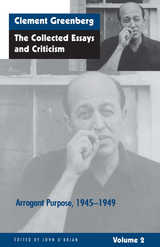 The Collected Essays and Criticism, Volume 2: Arrogant Purpose, 1945-1949
Clement Greenberg
University of Chicago Press, 1988 Clement Greenberg (1909–1994), champion of abstract expressionism and modernism—of Pollock, Miró, and Matisse—has been esteemed by many as the greatest art critic of the second half of the twentieth century, and possibly the greatest art critic of all time. On radio and in print, Greenberg was the voice of "the new American painting," and a central figure in the postwar cultural history of the United States. Greenberg first established his reputation writing for the Partisan Review, which he joined as an editor in 1940. He became art critic for the Nation in 1942, and was associate editor of Commentary from 1945 until 1957. His seminal essay, "Avant-Garde and Kitsch" set the terms for the ongoing debate about the relationship of modern high art to popular culture. Though many of his ideas have been challenged, Greenberg has influenced generations of critics, historians, and artists, and he remains influential to this day.
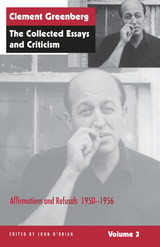 The Collected Essays and Criticism, Volume 3: Affirmations and Refusals, 1950-1956
Clement Greenberg
University of Chicago Press, 1995 Clement Greenberg is widely recognized as the most influential and articulate champion of modernism during its American ascendency after World War II, the period largely covered by these highly acclaimed volumes of The Collected Essays and Criticism. Volume 3: Affirmations and Refusals presents Greenberg's writings from the period between 1950 and 1956, while Volume 4: Modernism with a Vengeance gathers essays and criticism of the years 1957 to 1969. The 120 works range from little-known pieces originally appearing Vogue and Harper's Bazaar to such celebrated essays as "The Plight of Our Culture" (1953), "Modernist Painting" (1960), and "Post Painterly Abstraction" (1964). Preserved in their original form, these writings allow readers to witness the development and direction of Greenberg's criticism, from his advocacy of abstract expressionism to his enthusiasm for color-field painting.
With the inclusion of critical exchanges between Greenberg and F. R. Leavis, Fairfield Porter, Thomas B. Hess, Herbert Read, Max Kozloff, and Robert Goldwater, these volumes are essential sources in the ongoing debate over modern art. For each volume, John O'Brian has furnished an introduction, a selected bibliography, and a brief summary of events that places the criticism in its artistic and historical context.
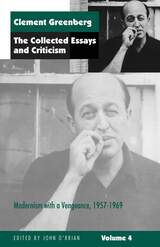 The Collected Essays and Criticism, Volume 4: Modernism with a Vengeance, 1957-1969
Clement Greenberg
University of Chicago Press, 1995 Clement Greenberg is widely recognized as the most influential and articulate champion of modernism during its American ascendency after World War II, the period largely covered by these highly acclaimed volumes of The Collected Essays and Criticism. Volume 3: Affirmations and Refusals presents Greenberg's writings from the period between 1950 and 1956, while Volume 4: Modernism with a Vengeance gathers essays and criticism of the years 1957 to 1969. The 120 works range from little-known pieces originally appearing Vogue and Harper's Bazaar to such celebrated essays as "The Plight of Our Culture" (1953), "Modernist Painting" (1960), and "Post Painterly Abstraction" (1964). Preserved in their original form, these writings allow readers to witness the development and direction of Greenberg's criticism, from his advocacy of abstract expressionism to his enthusiasm for color-field painting.
With the inclusion of critical exchanges between Greenberg and F. R. Leavis, Fairfield Porter, Thomas B. Hess, Herbert Read, Max Kozloff, and Robert Goldwater, these volumes are essential sources in the ongoing debate over modern art. For each volume, John O'Brian has furnished an introduction, a selected bibliography, and a brief summary of events that places the criticism in its artistic and historical context.
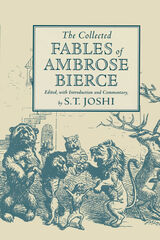 THE COLLECTED FABLES OF AMBROSE BIERCE
Ambrose Bierce, Edited with introduction and commentary by S. T. Joshi
Ohio State University Press, 2000 Ambrose Bierce was a well-known and highly admired journalist, short story writer, and satirist. After distinguished Civil War service, Bierce became a journalist, and in 1887 he became a columnist for William Randolph Hearst’s Sunday Examiner. His work for the San Francisco Examiner made his reputation, especially on the West Coast. In 1914 he vanished on a trip to Mexico. The work for which he is best know, The Devil’s Dictionary, was first published in 1906. Bierce also published volumes of short stories. His Tales of Soldiers and Civilians (1891) represents some of the finest writing to come out of the Civil War. Bierce’s stories of the supernatural, collected in Can Such Things Be? (1893), established him as one of the leading American authors of supernatural fiction. This volume gathers together for the first time the 850 fables written by Bierce over his forty-year career, including more than 400 fables never reprinted from the magazines and newspapers in which they originally appeared. Bierce’s fables are distinguished for their biting wit and their cynical reflection of the political and social events of his time. Local and national political figures; corrupt lawyers, judges, and clergymen; and even incidents in the Spanish-American War are all mercilessly lampooned. The fables not only testify to Bierce’s hatred of “hypocrisy, cant, and all sham” but provide a window into late nineteenth-century American society. S. T. Joshi has provided extensive commentary explaining historical and literary references in the fables.
 Collected Leonard J Arrington Mormon History Lectures
USU Special Collections
Utah State University Press, 2004 The first ten lectures in Leonard J. Arrington Mormon History Lecture Series are here collected in one volume. The series, established by one of the twentieth-century West's most distinguished historians, Leonard Arrington, has become a leading forum for prominent historians to address topics related to Mormon history. The first lecturer was Arrington himself. He was followed by Richard Lyman Bushman, Richard E. Bennett, Howard R. Lamar, Claudia L. Bushman, Kenneth W. Godfrey, Jan Shipps, Donald Worster, Laurel Thatcher Ulrich, and F. Ross Peterson. Utah State University hosts the Leonard J. Arrington Mormon History Lecture Series. The University Libraries' Special Collections and Archives houses the Arrington collection. The state's land grant university began collecting records very early, and in the 1960s became a major depository for Utah and Mormon records. Leonard and his wife Grace joined the USU faculty and family in 1946, and the Arringtons and their colleagues worked to collect original diaries, journals, letters, and photographs.
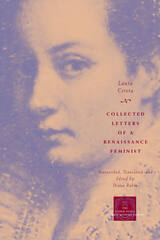 Collected Letters of a Renaissance Feminist
Laura Cereta
University of Chicago Press, 1997 Renaissance writer Laura Cereta (1469–1499) presents feminist issues in a predominantly male venue—the humanist autobiography in the form of personal letters. Cereta's works circulated widely in Italy during the early modern era, but her complete letters have never before been published in English. In her public lectures and essays, Cereta explores the history of women's contributions to the intellectual and political life of Europe. She argues against the slavery of women in marriage and for the rights of women to higher education, the same issues that have occupied feminist thinkers of later centuries.
Yet these letters also furnish a detailed portrait of an early modern woman’s private experience, for Cereta addressed many letters to a close circle of family and friends, discussing highly personal concerns such as her difficult relationships with her mother and her husband. Taken together, these letters are a testament both to an individual woman and to enduring feminist concerns.
 The Collected Letters of George Gissing Volume 5: 1892-1895
George Gissing
Ohio University Press, 1994 Gissing’s career, which spanned the period of about 1877 to his death in 1903, was characterized by prodigious output (almost a novel a year in the early days), modest recognition, and modest income. He wrote of poverty, socialism, class differences, social reform, and later on, about the problems of women and industrialization. His best known works are New Grub Street (1891) and Private Papers of Henry Ryecroft (1903), rich sources of social commentary that reflect a literary transition from the Victorian to the modern period. For many years, the only Gissing letters available to the public were those in the modest selection of letters to his family published in 1927. Now the editors have culled widely scattered sources—private and public collections, journals, newspapers, memoirs, biographies, and sales catalogs—to gather and organize Gissing’s correspondence, including letters to him, and to provide an editorial context. The years 1892-1895 saw an increase in the bulk and scope of Gissing’s literary production, coinciding with his new and cordial association with publishers Bullen and Lawrence. During this period, the partners published Denzil Quarrier, The Odd Women, In the Year of Jubilee, ad Eve’s Ransom, while A. and C. Black brought out Born in Exile. Gissing’s correspondence with his publishers, some of which is printed here for the first time, is matched in significance by his letters to his literary agent William Morris Colles and to editors such as Clement Shorter, who were instrumental in turning Gissing to the short story. His domestic life remained grim: his unfortunate marriage ruled out the possibility of satisfactory social relationships, and his anxiety over the care of his son Walter was eased only by sending the infant away to stay with strangers. New friends, especially Clara Collet and Edward Clodd, were a precious asset—in their presence he could be his better self, a highly cultured, joy-loving individual whose work was finding greater favor with the public.
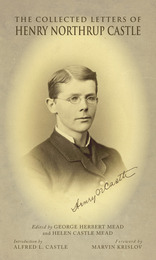 The Collected Letters of Henry Northrup Castle
Henry Northrup Castle
Ohio University Press, 2012 George Herbert Mead, one of America’s most important and influential philosophers, a founder of pragmatism, social psychology, and symbolic interactionism, was also a keen observer of American culture and early modernism. In the period from the 1870s to 1895, Henry Northrup Castle maintained a correspondence with family members and with Mead—his best friend at Oberlin College and brother-in-law—that reveals many of the intellectual, economic, and cultural forces that shaped American thought in that complex era. Close friends of John Dewey, Jane Addams, and other leading Chicago Progressives, the author of these often intimate letters comments frankly on pivotal events affecting higher education, developments at Oberlin College, Hawaii (where the Castles lived), progressivism, and the general angst that many young intellectuals were experiencing in early modern America.
The letters, drawn from the Mead-Castle collection at the University of Chicago, were collected and edited by Mead after the tragic death of Henry Castle in a shipping accident in the North Sea. Working with his wife Helen Castle (one of Henry’s sisters), he privately published fifty copies of the letters to record an important relationship and as an intellectual history of two progressive thinkers at the end of the nineteenth century. American historians, such as Robert Crunden and Gary Cook, have noted the importance of the letters to historians of the late nineteenth century.
The letters are made available here using the basic Mead text of 1902. Additional insights into the connection between Mead, John Dewey, Henry and Harriet Castle, and Hawaii’s progressive kindergarten system are provided by the foundation’s executive director Alfred L. Castle. Marvin Krislov, president of Oberlin College, has added additional comments on the importance of the letters to understanding the intellectual relationship that flourished at Oberlin College.
Published with the support of the Samuel N. and Mary Castle Foundation.
 The Collected letters of Sir Arthur Pinero
Arthur Wing PineroJ.P. Wearing, Editor
University of Minnesota Press, 1974
The Collected letters of Sir Arthur Pinero was first published in 1974. Minnesota Archive Editions uses digital technology to make long-unavailable books once again accessible, and are published unaltered from the original University of Minnesota Press editions.
Sir Arthur Pinero's letters, in the collection published in this volume, present a vivid, behind-the-scenes look at the theater in England in the late nineteenth and early twentieth centuries. Sir Arthur was one of the most important and influential playwrights of the English stage during his lifetime. These letters, 337 in number, most of which have not been published before, span a period of sixty years, from 1873, when Pinero began his career as an actor at the age of eighteen, to 1933, the year before his death.
Pinero was totally absorbed with the theater, and his correspondence provides a record of his ideas about his own work and the contemporary theatrical climate. From his earlier years he gives us impressions of the famous actors and actresses of the period—Henry Irving, Ellen Terry, and the Bancrofts, who were his favorites—and he later acted with them, too.
The letters trace well the growth of Pinero's work as a dramatist, and are especially valuable because he wrote little publicly on dramatic theory in general or on his own work in particular. They reveal a dramatist who knew exactly what he wanted in the theater and how he felt it ought to be realized on the stage. He devoted much time and discussion to the careful choosing of a cast and other aspects of production. The letters tell, with as well as reporting on the critical and public reception of his plays. The correspondence also demonstrates his involvement with the development of the native English drama in its own right, and includes forthright comments on Ibsen and on continental drama generally.
Many of the letters are addressed to such notables as Henry James, Edmund Gosse, George Bernard Shaw, Henry Irving, and Sir George Alexander, all major theatrical figures at the turn of the century.
The Collected Letters of Thomas and Jane Welsh Carlyle: 1822–23, Volume 2
Charles Richard Sanders
Duke University Press The Collected Letters of Thomas and Jane Welsh Carlyle offer a window onto the lives of two of the Victorian world’s most accomplished, perceptive, and unusual inhabitants. Scottish writer and historian Thomas Carlyle and his wife, Jane Welsh Carlyle, attracted to them a circle of foreign exiles, radicals, feminists, revolutionaries, and major and minor writers from across Europe and the United States. The collection is regarded as one of the finest and most comprehensive literary archives of the nineteenth century.
The Collected Letters of Thomas and Jane Welsh Carlyle: 1824–25, Volume 3
Charles Richard Sanders
Duke University Press The Collected Letters of Thomas and Jane Welsh Carlyle offer a window onto the lives of two of the Victorian world’s most accomplished, perceptive, and unusual inhabitants. Scottish writer and historian Thomas Carlyle and his wife, Jane Welsh Carlyle, attracted to them a circle of foreign exiles, radicals, feminists, revolutionaries, and major and minor writers from across Europe and the United States. The collection is regarded as one of the finest and most comprehensive literary archives of the nineteenth century.
The Collected Letters of Thomas and Jane Welsh Carlyle: 1826–28, Volume 4
Charles Richard Sanders
Duke University Press The Collected Letters of Thomas and Jane Welsh Carlyle offer a window onto the lives of two of the Victorian world’s most accomplished, perceptive, and unusual inhabitants. Scottish writer and historian Thomas Carlyle and his wife, Jane Welsh Carlyle, attracted to them a circle of foreign exiles, radicals, feminists, revolutionaries, and major and minor writers from across Europe and the United States. The collection is regarded as one of the finest and most comprehensive literary archives of the nineteenth century.
The Collected Letters of Thomas and Jane Welsh Carlyle: 1838, Volume 10
Charles Richard Sanders
Duke University Press The Collected Letters of Thomas and Jane Welsh Carlyle offer a window onto the lives of two of the Victorian world’s most accomplished, perceptive, and unusual inhabitants. Scottish writer and historian Thomas Carlyle and his wife, Jane Welsh Carlyle, attracted to them a circle of foreign exiles, radicals, feminists, revolutionaries, and major and minor writers from across Europe and the United States. The collection is regarded as one of the finest and most comprehensive literary archives of the nineteenth century.
The Collected Letters of Thomas and Jane Welsh Carlyle: 1839, Volume 11
Charles Richard Sanders
Duke University Press The Collected Letters of Thomas and Jane Welsh Carlyle offer a window onto the lives of two of the Victorian world’s most accomplished, perceptive, and unusual inhabitants. Scottish writer and historian Thomas Carlyle and his wife, Jane Welsh Carlyle, attracted to them a circle of foreign exiles, radicals, feminists, revolutionaries, and major and minor writers from across Europe and the United States. The collection is regarded as one of the finest and most comprehensive literary archives of the nineteenth century.
The Collected Letters of Thomas and Jane Welsh Carlyle: 1840, Volume 12
Charles Richard Sanders
Duke University Press The Collected Letters of Thomas and Jane Welsh Carlyle offer a window onto the lives of two of the Victorian world’s most accomplished, perceptive, and unusual inhabitants. Scottish writer and historian Thomas Carlyle and his wife, Jane Welsh Carlyle, attracted to them a circle of foreign exiles, radicals, feminists, revolutionaries, and major and minor writers from across Europe and the United States. The collection is regarded as one of the finest and most comprehensive literary archives of the nineteenth century.
The Collected Letters of Thomas and Jane Welsh Carlyle: 1841, Volume 13
Clyde de L. Ryals and Kenneth J. Fielding
Duke University Press The Collected Letters of Thomas and Jane Welsh Carlyle offer a window onto the lives of two of the Victorian world’s most accomplished, perceptive, and unusual inhabitants. Scottish writer and historian Thomas Carlyle and his wife, Jane Welsh Carlyle, attracted to them a circle of foreign exiles, radicals, feminists, revolutionaries, and major and minor writers from across Europe and the United States. The collection is regarded as one of the finest and most comprehensive literary archives of the nineteenth century.
The Collected Letters of Thomas and Jane Welsh Carlyle: 1852, Volume 27
Clyde de L. Ryals and Kenneth J. Fielding
Duke University Press The Collected Letters of Thomas and Jane Welsh Carlyle offer a window onto the lives of two of the Victorian world’s most accomplished, perceptive, and unusual inhabitants. Scottish writer and historian Thomas Carlyle and his wife, Jane Welsh Carlyle, attracted to them a circle of foreign exiles, radicals, feminists, revolutionaries, and major and minor writers from across Europe and the United States. The collection is regarded as one of the finest and most comprehensive literary archives of the nineteenth century.
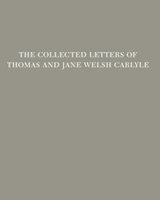 The Collected Letters of Thomas and Jane Welsh Carlyle: 1853, Volume 28
Kenneth J. Fielding, Ian Campbell, Aileen Christianson, David Sorensen
Duke University Press Don’t miss a single volume. Subscribe today!
Back volumes are available for purchase. To ensure that you don't miss a single issue, subscribe to The Collected Letters of Thomas and Jane Welsh Carlyle today. For more information, click here. Four occurrences pervade this new collection of letters: the decline and death of Thomas Carlyle’s mother; Thomas’s continued research of Frederick the Great; the Carlyles’s struggle against the perpetual irritation of urban noise, particularly roosters, which led to the construction of a soundproof room; and the Carlyles’ introduction to Talbotypes, an early form of photography. While domestic concerns pervade the volume, it also provides the usual insight into societal and political culture of the 1850s through the couple’s interaction with influential figures, including Charles Dickens, Ralph Waldo Emerson, and Delia Bacon.
The Collected Letters of Thomas and Jane Welsh Carlyle: April 1848–March 1849, Volume 23
Clyde de L. Ryals and Kenneth J. Fielding
Duke University Press The Collected Letters of Thomas and Jane Welsh Carlyle offer a window onto the lives of two of the Victorian world’s most accomplished, perceptive, and unusual inhabitants. Scottish writer and historian Thomas Carlyle and his wife, Jane Welsh Carlyle, attracted to them a circle of foreign exiles, radicals, feminists, revolutionaries, and major and minor writers from across Europe and the United States. The collection is regarded as one of the finest and most comprehensive literary archives of the nineteenth century.
The Collected Letters of Thomas and Jane Welsh Carlyle: April–December 1844, Volume 18
Clyde de L. Ryals and Kenneth J. Fielding
Duke University Press The Collected Letters of Thomas and Jane Welsh Carlyle offer a window onto the lives of two of the Victorian world’s most accomplished, perceptive, and unusual inhabitants. Scottish writer and historian Thomas Carlyle and his wife, Jane Welsh Carlyle, attracted to them a circle of foreign exiles, radicals, feminists, revolutionaries, and major and minor writers from across Europe and the United States. The collection is regarded as one of the finest and most comprehensive literary archives of the nineteenth century.
The Collected Letters of Thomas and Jane Welsh Carlyle: April–December 1849: April–December 1849, Volume 24
Clyde de L. Ryals and Kenneth J. Fielding
Duke University Press The Collected Letters of Thomas and Jane Welsh Carlyle offer a window onto the lives of two of the Victorian world’s most accomplished, perceptive, and unusual inhabitants. Scottish writer and historian Thomas Carlyle and his wife, Jane Welsh Carlyle, attracted to them a circle of foreign exiles, radicals, feminists, revolutionaries, and major and minor writers from across Europe and the United States. The collection is regarded as one of the finest and most comprehensive literary archives of the nineteenth century.
The Collected Letters of Thomas and Jane Welsh Carlyle: August 1843–March 1844, Volume 17
Clyde de L. Ryals and Kenneth J. Fielding
Duke University Press The Collected Letters of Thomas and Jane Welsh Carlyle offer a window onto the lives of two of the Victorian world’s most accomplished, perceptive, and unusual inhabitants. Scottish writer and historian Thomas Carlyle and his wife, Jane Welsh Carlyle, attracted to them a circle of foreign exiles, radicals, feminists, revolutionaries, and major and minor writers from across Europe and the United States. The collection is regarded as one of the finest and most comprehensive literary archives of the nineteenth century.
The Collected Letters of Thomas and Jane Welsh Carlyle: August 1846–June 1847, Volume 21
Clyde de L. Ryals and Kenneth J. Fielding
Duke University Press The Collected Letters of Thomas and Jane Welsh Carlyle offer a window onto the lives of two of the Victorian world’s most accomplished, perceptive, and unusual inhabitants. Scottish writer and historian Thomas Carlyle and his wife, Jane Welsh Carlyle, attracted to them a circle of foreign exiles, radicals, feminists, revolutionaries, and major and minor writers from across Europe and the United States. The collection is regarded as one of the finest and most comprehensive literary archives of the nineteenth century.
The Collected Letters of Thomas and Jane Welsh Carlyle: January 1829–September 1831, Volume 5
Charles Richard Sanders
Duke University Press The Collected Letters of Thomas and Jane Welsh Carlyle offer a window onto the lives of two of the Victorian world’s most accomplished, perceptive, and unusual inhabitants. Scottish writer and historian Thomas Carlyle and his wife, Jane Welsh Carlyle, attracted to them a circle of foreign exiles, radicals, feminists, revolutionaries, and major and minor writers from across Europe and the United States. The collection is regarded as one of the finest and most comprehensive literary archives of the nineteenth century.
The Collected Letters of Thomas and Jane Welsh Carlyle: January 1835–June 1836, Volume 8
Charles Richard Sanders
Duke University Press The Collected Letters of Thomas and Jane Welsh Carlyle offer a window onto the lives of two of the Victorian world’s most accomplished, perceptive, and unusual inhabitants. Scottish writer and historian Thomas Carlyle and his wife, Jane Welsh Carlyle, attracted to them a circle of foreign exiles, radicals, feminists, revolutionaries, and major and minor writers from across Europe and the United States. The collection is regarded as one of the finest and most comprehensive literary archives of the nineteenth century.
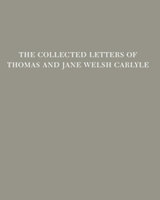 The Collected Letters of Thomas and Jane Welsh Carlyle: January 1854-June 1855, Volume 29
Kenneth J. Fielding, Ian Campbell, Sheila McIntosh, and David Sorensen
Duke University Press Don’t miss a single volume. Subscribe today!
Back volumes are available for purchase. To ensure that you don't miss a single issue, subscribe to The Collected Letters of Thomas and Jane Welsh Carlyle today. For more information, click here. Volume 29 resumes themes begun in earlier letters: Thomas's flirtatious exchanges with Lady Ashburton, the recent death of his mother, the improvement of his soundproof room, and his struggle to pursue his research for Frederick the Great. Other notable items include Dickens's dedication of Hard Times to Thomas and Thomas's support of G. H. Lewes during the scandal over Lewes's affair with George Eliot. The highlight of the volume is a passionate and humorous letter by Jane, subtitled "Budget of a Femme Incomprise," in which she defends the rising cost of running their house.
The Collected Letters of Thomas and Jane Welsh Carlyle: January–December 1850, Volume 25
Clyde de L. Ryals and Kenneth J. Fielding
Duke University Press The Collected Letters of Thomas and Jane Welsh Carlyle offer a window onto the lives of two of the Victorian world’s most accomplished, perceptive, and unusual inhabitants. Scottish writer and historian Thomas Carlyle and his wife, Jane Welsh Carlyle, attracted to them a circle of foreign exiles, radicals, feminists, revolutionaries, and major and minor writers from across Europe and the United States. The collection is regarded as one of the finest and most comprehensive literary archives of the nineteenth century.
The Collected Letters of Thomas and Jane Welsh Carlyle: January–December 1851, Volume 26
Clyde de L. Ryals and Kenneth J. Fielding
Duke University Press The Collected Letters of Thomas and Jane Welsh Carlyle offer a window onto the lives of two of the Victorian world’s most accomplished, perceptive, and unusual inhabitants. Scottish writer and historian Thomas Carlyle and his wife, Jane Welsh Carlyle, attracted to them a circle of foreign exiles, radicals, feminists, revolutionaries, and major and minor writers from across Europe and the United States. The collection is regarded as one of the finest and most comprehensive literary archives of the nineteenth century.
The Collected Letters of Thomas and Jane Welsh Carlyle: January–July 1842, Volume 14
Clyde de L. Ryals and Kenneth J. Fielding
Duke University Press The Collected Letters of Thomas and Jane Welsh Carlyle offer a window onto the lives of two of the Victorian world’s most accomplished, perceptive, and unusual inhabitants. Scottish writer and historian Thomas Carlyle and his wife, Jane Welsh Carlyle, attracted to them a circle of foreign exiles, radicals, feminists, revolutionaries, and major and minor writers from across Europe and the United States. The collection is regarded as one of the finest and most comprehensive literary archives of the nineteenth century.
The Collected Letters of Thomas and Jane Welsh Carlyle: January–July 1843, Volume 16
Clyde de L. Ryals and Kenneth J. Fielding
Duke University Press The Collected Letters of Thomas and Jane Welsh Carlyle offer a window onto the lives of two of the Victorian world’s most accomplished, perceptive, and unusual inhabitants. Scottish writer and historian Thomas Carlyle and his wife, Jane Welsh Carlyle, attracted to them a circle of foreign exiles, radicals, feminists, revolutionaries, and major and minor writers from across Europe and the United States. The collection is regarded as one of the finest and most comprehensive literary archives of the nineteenth century.
The Collected Letters of Thomas and Jane Welsh Carlyle: January–October 1859, Volume 35
Brent E. Kinser
Duke University Press The Collected Letters of Thomas and Jane Welsh Carlyle offer a window onto the lives of two of the Victorian world’s most accomplished, perceptive, and unusual inhabitants. Scottish writer and historian Thomas Carlyle and his wife, Jane Welsh Carlyle, attracted to them a circle of foreign exiles, radicals, feminists, revolutionaries, and major and minor writers from across Europe and the United States. The collection is regarded as one of the finest and most comprehensive literary archives of the nineteenth century.
The Collected Letters of Thomas and Jane Welsh Carlyle: January–September 1845, Volume 19
Clyde de L. Ryals and Kenneth J. Fielding
Duke University Press The Collected Letters of Thomas and Jane Welsh Carlyle offer a window onto the lives of two of the Victorian world’s most accomplished, perceptive, and unusual inhabitants. Scottish writer and historian Thomas Carlyle and his wife, Jane Welsh Carlyle, attracted to them a circle of foreign exiles, radicals, feminists, revolutionaries, and major and minor writers from across Europe and the United States. The collection is regarded as one of the finest and most comprehensive literary archives of the nineteenth century.
The Collected Letters of Thomas and Jane Welsh Carlyle: January-September 1856, Volume 31
Ian Campbell, Aileen Christianson, Sheila McIntosh, and David Sorensen
Duke University Press The Collected Letters of Thomas and Jane Welsh Carlyle offer a window onto the lives of two of the Victorian world’s most accomplished, perceptive, and unusual inhabitants. Scottish writer and historian Thomas Carlyle and his wife, Jane Welsh Carlyle, attracted to them a circle of foreign exiles, radicals, feminists, revolutionaries, and major and minor writers from across Europe and the United States. The collection is regarded as one of the finest and most comprehensive literary archives of the nineteenth century. In volume 31, which covers the year 1856, the Carlyles continue a rigorous correspondence, depicting and examining Victorian London as well as its inhabitants. They also return to their native Scotland and offer details of their travels in the Scottish Lowlands and Highlands.
The Collected Letters of Thomas and Jane Welsh Carlyle: July 1836–December 1837, Volume 9
Charles Richard Sanders
Duke University Press The Collected Letters of Thomas and Jane Welsh Carlyle offer a window onto the lives of two of the Victorian world’s most accomplished, perceptive, and unusual inhabitants. Scottish writer and historian Thomas Carlyle and his wife, Jane Welsh Carlyle, attracted to them a circle of foreign exiles, radicals, feminists, revolutionaries, and major and minor writers from across Europe and the United States. The collection is regarded as one of the finest and most comprehensive literary archives of the nineteenth century.
The Collected Letters of Thomas and Jane Welsh Carlyle: July 1847–March 1848, Volume 22
Clyde de L. Ryals and Kenneth J. Fielding
Duke University Press The Collected Letters of Thomas and Jane Welsh Carlyle offer a window onto the lives of two of the Victorian world’s most accomplished, perceptive, and unusual inhabitants. Scottish writer and historian Thomas Carlyle and his wife, Jane Welsh Carlyle, attracted to them a circle of foreign exiles, radicals, feminists, revolutionaries, and major and minor writers from across Europe and the United States. The collection is regarded as one of the finest and most comprehensive literary archives of the nineteenth century.
The Collected Letters of Thomas and Jane Welsh Carlyle: July–December 1842, Volume 15
Clyde de L. Ryals and Kenneth J. Fielding
Duke University Press The Collected Letters of Thomas and Jane Welsh Carlyle offer a window onto the lives of two of the Victorian world’s most accomplished, perceptive, and unusual inhabitants. Scottish writer and historian Thomas Carlyle and his wife, Jane Welsh Carlyle, attracted to them a circle of foreign exiles, radicals, feminists, revolutionaries, and major and minor writers from across Europe and the United States. The collection is regarded as one of the finest and most comprehensive literary archives of the nineteenth century.
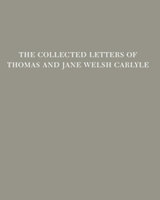 The Collected Letters of Thomas and Jane Welsh Carlyle: July-December 1855, Volume 30
Ian Campbell, Aileen Christianson, Sheila McIntosh, and David Sorensen
Duke University Press Don’t miss a single volume. Subscribe today!
Back volumes are available for purchase. To ensure that you don't miss a single issue, subscribe to The Collected Letters of Thomas and Jane Welsh Carlyle today. For more information, click here. Volume 30 illuminates Jane's inner life with the help of two previously unpublished documents: her complete journals from the years 1845-1852 and 1855-1856 and an interview conducted by her friend Ellen Twiselton that chronicles a painful period in the Carlyle marriage. Also included here is Jane's story, "The Simple Story of My Own First Love," and discussions of her complicated relations with feminists, whom she admired yet distrusted. Meanwhile, Thomas is mired in his remarkable study of Frederick the Great, a figure he reveres as an exemplar of "veracity" in a shallow age—an image of Carlyle himself.
The Collected Letters of Thomas and Jane Welsh Carlyle: October 1831–September 1833, Volume 6
Charles Richard Sanders
Duke University Press The Collected Letters of Thomas and Jane Welsh Carlyle offer a window onto the lives of two of the Victorian world’s most accomplished, perceptive, and unusual inhabitants. Scottish writer and historian Thomas Carlyle and his wife, Jane Welsh Carlyle, attracted to them a circle of foreign exiles, radicals, feminists, revolutionaries, and major and minor writers from across Europe and the United States. The collection is regarded as one of the finest and most comprehensive literary archives of the nineteenth century.
The Collected Letters of Thomas and Jane Welsh Carlyle: October 1833–December 1834, Volume 7
Charles Richard Sanders
Duke University Press The Collected Letters of Thomas and Jane Welsh Carlyle offer a window onto the lives of two of the Victorian world’s most accomplished, perceptive, and unusual inhabitants. Scottish writer and historian Thomas Carlyle and his wife, Jane Welsh Carlyle, attracted to them a circle of foreign exiles, radicals, feminists, revolutionaries, and major and minor writers from across Europe and the United States. The collection is regarded as one of the finest and most comprehensive literary archives of the nineteenth century.
The Collected Letters of Thomas and Jane Welsh Carlyle: October 1845–July 1846, Volume 20
Clyde de L. Ryals and Kenneth J. Fielding
Duke University Press The Collected Letters of Thomas and Jane Welsh Carlyle offer a window onto the lives of two of the Victorian world’s most accomplished, perceptive, and unusual inhabitants. Scottish writer and historian Thomas Carlyle and his wife, Jane Welsh Carlyle, attracted to them a circle of foreign exiles, radicals, feminists, revolutionaries, and major and minor writers from across Europe and the United States. The collection is regarded as one of the finest and most comprehensive literary archives of the nineteenth century.
 The Collected Letters of Thomas and Jane Welsh Carlyle: October 1856-July 1857, Volume 32
Ian Campbell, Aileen Christianson, Sheila McIntosh, and David Sorensen
Duke University Press The Collected Letters of Thomas and Jane Welsh Carlyle offer a window onto the lives of two of the Victorian world’s most accomplished, perceptive, and unusual inhabitants. Scottish writer and historian Thomas Carlyle and his wife, Jane Welsh Carlyle, attracted to them a circle of foreign exiles, radicals, feminists, revolutionaries, and major and minor writers from across Europe and the United States. The collection is regarded as one of the finest and most comprehensive literary archives of the nineteenth century. Volume 32 covers the period from October 1856 to July 1857. During this time, Jane is beset with a succession of illnesses, while Thomas prepares the first two books of his massive History of Frederick the Great for publication and labors on his publisher's proposed new "cheap" edition of his works. The "Indian mutiny," the bombardment of Canton, and a dissolution of the British Parliament also feature in this volume. In addition to its 168 richly annotated letters, many published here for the first time, volume 32 includes two appendixes: (1) advertisements in the Athenaeum for the "cheap edition" from December 1856 to December 1858 and (2) a transcription of Thomas Carlyle's marginal comments on a borrowed copy of Elizabeth Barrett Browning's Aurora Leigh.
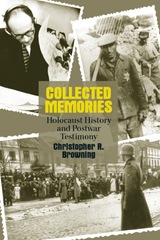 Collected Memories: Holocaust History and Postwar Testimony
Christopher R. Browning
University of Wisconsin Press, 2003 Christopher R. Browning addresses some of the most heated controversies that have arisen from the use of postwar testimony: Hannah Arendt’s uncritical acceptance of Adolf Eichmann’s self-portrayal in Jerusalem; the conviction of Ivan Demjanuk (accused of being Treblinka death camp guard "Ivan the Terrible") on the basis of survivor testimony and its subsequent reversal by the Israeli Supreme Court; the debate in Poland sparked by Jan Gross’s use of both survivor and communist courtroom testimony in his book Neighbors; and the conflict between Browning himself and Daniel Goldhagen, author of Hitler’s Willing Executioners, regarding methodology and interpretation in the use of pre-trial testimony.
Despite these controversies and challenges, Browning delineates the ways in which the critical use of such problematic sources can provide telling evidence for writing Holocaust history. He examines and discusses two starkly different sets of "collected memories"—the voluminous testimonies of notorious Holocaust perpetrator Adolf Eichmann and the testimonies of 175 survivors of an obscure complex of factory slave labor camps in the Polish town of Starachowice.
 Collected Papers
Lloyd A. Metzler
Harvard University Press, 1973 A pioneer in bringing mathematical methods into everyday use in economics, Lloyd A. Metzler is well known for his adroit use of formal tools and exceptionally readable prose style which have provided a generation of economists with clear solutions to difficult analytical problems. The papers collected in this volume, including four previously unpublished, retain a freshness and clarity that is readily recognized by today's students of economics.
Over the years Mr. Metzler's contributions to economic theory have ranged widely over the fields of international economics, macroeconomic theory, business fluctuations, and the mathematical theory of general equilibrium. Most notably, he carries Lord Keynes's theories further, working out the essential properties of the foreign-trade multiplier. His discussions of tariff repercussions, capital transfers, and stability conditions in the foreign-exchange market are of vital importance to today's dramatic efforts to achieve economic stability throughout the world.
Collected Papers, enhanced by many tables and figures and clearly indicative of the author's far-reaching economic mind, is organized into four sections: The Theory of International Trade; Money, Interest, and Prices; Business Cycles and Economic Fluctuations; and Mathematical Economics and Statistics. Two of the articles in this volume were part of the author's doctoral thesis which was awarded the David A. Wells Prize at Harvard University.
 Collected Papers
John Rawls
Harvard University Press, 1999 John Rawls’s work on justice has drawn more commentary and aroused wider attention than any other work in moral or political philosophy in the twentieth century. Rawls is the author of two major treatises, A Theory of Justice (1971) and Political Liberalism (1993); it is said that A Theory of Justice revived political philosophy in the English-speaking world.
But before and after writing his great treatises Rawls produced a steady stream of essays. Some of these essays articulate views of justice and liberalism distinct from those found in the two books. They are important in and of themselves because of the deep issues about the nature of justice, moral reasoning, and liberalism they raise as well as for the light they shed on the evolution of Rawls’s views. Some of the articles tackle issues not addressed in either book. They help identify some of the paths open to liberal theorists of justice and some of the knotty problems which liberal theorists must seek to resolve.
A complete collection of John Rawls’s essays is long overdue.
 Collected Papers of Charles Sanders Peirce
Charles Sanders Peirce
Harvard University Press This volume contains the published contributions of one of the founders of modern logic and America’s greatest logical genius. It is not only of historical but of contemporary interest because of its many acute discussions of fundamental logical problems. To assist the general reader, the editors have prefixed to the text a selected list of important topics and have provided many footnotes and an exhaustive index.
The present, the longest volume of the series of Peirce’s Collected Papers, reveals most clearly his stature as a logician and a student of the foundations of mathematics. It includes not only some striking anticipations of recent work in logic and the foundations of mathematics but also a number of vital contributions to these subjects as now understood. In addition there is an entirely original treatment of logical diagrams which makes possible a detailed analysis of the process of reasoning and provides the link between modern logic and Peirce’s conception of pragmatism. It is the most advanced and important of the volumes on exact logic.
Collected Papers of Charles Sanders Peirce
Charles Sanders Peirce
Harvard University Press Charles Sanders Peirce has been characterized as the greatest American philosophic genius. He is the creator of pragmatism and one of the founders of modern logic. James, Royce, Schroder, and Dewey have acknowledged their great indebtedness to him. A laboratory scientist, he made notable contributions to geodesy, astronomy, psychology, induction, probability, and scientific method. He introduced into modern philosophy the doctrine of scholastic realism, developed the concepts of chance, continuity, and objective law, and showed the philosophical significance of the theory of signs and mathematical logic. The present series is the first published edition of his systematic works.
Collected Papers of Charles Sanders Peirce
Charles Sanders Peirce
Harvard University Press With the present volume, the presentation of Peirce’s philosophical thought reaches its metaphysical culmination. It embodies the effort of the founder of Pragmatism to develop a metaphysics which will conform to the canons of scientific method, and at the same time provide for real novelty, objective universal laws of nature, cosmical and biological evolution, feeling, and mind. To his previously published papers on chance, continuity, God, and other metaphysical themes, the editors have added a considerable number of unpublished manuscripts which clarify and develop the implications of Peirce’s fundamental world-view. The volume contains those speculative views of Peirce which so deeply influenced his contemporaries, including his discussions of tychism and synechism and of the religious aspects of metaphysics.
 Collected Papers of Charles Sanders Peirce
Charles Sanders Peirce
Harvard University Press The first six volumes of the Collected Papers of Charles Sanders Peirce included Peirce’s main writings in general philosophy, logic (deductive, inductive, and symbolic), pragmatism, and metaphysics. Volumes VII and VIII are a continuation of this series. Originally published as two separate volumes, they now appear in one book as part of the Belknap Press edition. Volume VII contains papers on experimental science, scientific method, and philosophy of mind. Volume VIII contains selections from Peirce’s reviews and correspondence and a bibliography of his published works, speeches and correspondence, and works by other authors which quote or describe manuscripts by Peirce which are not included in Volumes I–VIII of Collected Papers.
As is true of the series as a whole, the material in these volumes is not readily accessible elsewhere. Many of the manuscripts have never been published before, and the previously published material which is included is widely scattered in a number of journals.
Peirce’s work in experimental science played an important role in his life and in the formation of his philosophy, and Volume VII is designed to show how the principal focus of his attention shifted from this sphere to the methods of science and finally to speculative metaphysics. Thus it includes his only published article in experimental psychology and two short pieces on gravity as well as the most important part of “The Logic of 1873” (in which pragmatism was first formulated in writing); “The Logic of Drawing History from Ancient Documents,” discussion of the historical method; “Economy of Research” (1879), containing many pertinent reflections on scientific methodology of interest to research directors today; and much more.
America’s first original philosopher and logician, and the founder of the philosophy of pragmatism, Peirce was also influential in shaping the thinking of such figures as William James and John Dewey. The reviews and correspondence contained in Volume VIII show his attitude toward these philosophies and illustrate the nature of his relationships with the great thinkers of his day.
The bibliography in Volume VIII lists chronologically all of Peirce’s known published works, giving a clear picture of the development of his thought from 1860 through 1911. It is more complete than any published so far in that many new items are included and items previously listed in different sources are here brought together.
These volumes will be of great value to all persons interested in philosophy, scientific method, psychology, the methodology of history, and American studies in general.
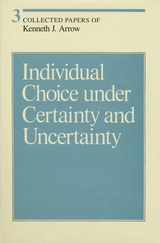 Collected Papers of Kenneth J. Arrow
Kenneth J. Arrow
Harvard University Press, 1984 Unlike the papers of some other great economists, those of Kenneth Arrow are being read and studied today with even greater care and attention than when they first appeared in the journals. The publication of his collected papers will therefore be welcomed by economists and other social scientists and in particular by graduate students, who can draw from them the deep knowledge and the discernment in selection of scientific problems that only a master can offer. The author has added headnotes to certain well-known papers, describing how he came to write them.
The third volume of Kenneth Arrow's Collected Papers concerns the basic concept of rationality as it applies to an economic decision maker. In particular, it addresses the problem of choice faced by consumers in a multicommodity world and presents specific models of choice useful in economic analysis. It also discusses choice models under uncertainty, giving the basic theory and critiques of this theory based on experimental evidence and applications. Among the major papers are "Alternative Approaches to the Theory of Choice in Risk-Taking Situations," a masterly survey of subjective probability and choice theory, and "The Theory of Risk Aversion," an exposition of the theory of choice under uncertainty.
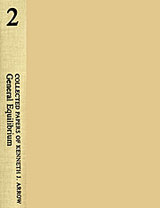 Collected Papers of Kenneth J. Arrow
Kenneth J. Arrow
Harvard University Press, 1983 Unlike the papers of some other great economists, those of Kenneth Arrow are being read and studied today with even greater care and attention than when they first appeared in journals. This publication of his collected papers, to be completed in seven topical volumes, will be welcomed by economists and other social scientists and in particular by graduate students, who can draw from them the deep knowledge and taste in the selection of scientific problems that only a master can offer.
This volume is concerned with the foundations of neo-classical economic analysis. General equilibrium is a theory of prices in which all of the actions of the economic agents in an economy are determined simultaneously and in a decentralized fashion. The price system, determined in competitive markets, guides actions for both firms and individual consumers. All of the complex interrelations of the economy are distilled into the determination of this price system.
In these papers, Arrow examines the conditions under which such a price system would exist. He also clarifies the conditions under which the system can or cannot achieve an optimum. In the latter case, when “market failures” are present, he shows the role of a benevolent government in helping to overcome the induced inefficiencies.
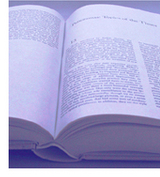 Collected Papers of Kenneth J. Arrow
Kenneth J. Arrow
Harvard University Press, 1983 Unlike the papers of some other great economists, those of Kenneth Arrow are being read and studied today with even greater care and attention than when they first appeared in the journals. The publication of his collected papers will therefore be welcomed by economists and other social scientists and in particular by graduate students, who can draw from them the deep knowledge and the discernment in selection of scientific problems that only a master can offer. The author has added headnotes to certain well-known papers, describing how he came to write them.
This volume begins with Arrow's papers on statistical decision theory, which served as a foundation for his work on the economics of information. As he writes in his preface, "Statistical method was an example for the acquisition of information. In a world of uncertainty, it was no great leap to realize that information is valuable in an economic sense." The later, applied papers, which operationalize the theory of the early ones, include essays on the demand for information, the economic value of screening devices, and the effect of incomplete information on the structure of organizations, futures markets, and insurance.
 Collected Papers of Kenneth J. Arrow
Kenneth J. Arrow
Harvard University Press, 1985 Unlike the papers of some other great economists, those of Kenneth Arrow are being read and studied today with even greater care and attention than when they first appeared in the journals. The publication of his collected papers will therefore be welcomed by economists and other social scientists and in particular by graduate students, who can draw from them the deep knowledge and the discernment in selection of scientific problems that only a master can offer. The author has added headnotes to certain well-known papers, describing how he came to write them.
The study of production is central to economic theory, and capital and its accumulation are two of the most interesting aspects of the modern production process. Capital may take the form of inventories of inputs, inventories of outputs, or machines and other fixed goods. The essential and unique aspect of all types of capital is that it must be accumulated as the result of prior stages of the production process. This gives the dynamic theory of production a recursive structure that can be exploited by economic analysis. The optimization of production under recursive conditions lends itself to general mathematical methods of dynamic programming and optimal control theory. This is the main theme of the essays included in this fifth volume of Kenneth Arrow's Collected Papers.
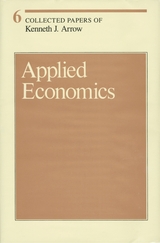 Collected Papers of Kenneth J. Arrow
Kenneth J. Arrow
Harvard University Press, 1985 Unlike the papers of some other great economists, those of Kenneth Arrow are being read and studied today with even greater care and attention than when they first appeared in the journals. The publication of his collected papers will therefore be welcomed by economists and other social scientists and in particular by graduate students, who can draw from them the deep knowledge and the discernment in selection of scientific problems that only a master can offer. The author has added headnotes to certain well-known papers, describing how he came to write them.
Although economic theory has been Kenneth Arrow's comparative advantage as well as his special interest, from time to time he has turned his attention to applied problems, often with unexpected results. A request from the Ford Foundation to write a survey of health economics led to his famous paper, "Uncertainty and the Welfare Economics of Medical Care," which raised for the first time many issues in the economics of information, particularly what are now called incentive compatibility issues. Other fruitful papers included in this volume deal with racial discrimination, the cost of oil imports, health insurance, environmental resources, and urban economics. Arrow's main interest in studying these disparate problems has been their potential source for new theory as well as their policy applications.
 Collected Papers of Kenneth J. Arrow
Kenneth J. Arrow
Harvard University Press, 1983 Unlike the papers of some other great economists, those of Kenneth Arrow are being read and studied today with even greater care and attention than when they first appeared in the journals. The publication of his collected papers will therefore be welcomed by economists and other social scientists and in particular by graduate students, who can draw from them the deep knowledge and the discernment in selection of scientific problems that only a master can offer. The author has added headnotes to certain well-known papers, describing how he came to write them.
In this first volume, Arrow takes up the basic question of whether collective choices can be made in such a way as to reflect individual preferences. The seminal 1950 paper that opens the volume shows that given certain reasonable conditions that social choices must satisfy to reflect individual preferences, it is impossible to make a choice among all sets of alternatives without violating some of the conditions. The subsequent papers extend, deepen, and clarify these results and examine the concept of justice, both in the abstract and in economic models. The volume also contains searching critiques of the theories of justice of John Rawls and Robert Nozick.
Collected Papers of Martin Kay: A Half Century of Computational Linguistics
Martin Kay, with the editorial assistance of Dan Flickinger and Stephan Oepen
CSLI, 2010 Since the dawn of the age of computers, researchers have been pushing the limits of available processing power to tackle the formidable challenge of developing software that can understand ordinary human language. At the forefront of this quest for the past fifty years, Martin Kay has been a constant source of new algorithms which have proven fundamental to progress in computational linguistics. Collected Papers of Martin Kay, the first comprehensive collection of his works to date, opens a window into the growth of an increasingly important field of scientific research and development.
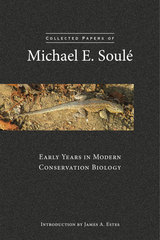 Collected Papers of Michael E. Soulé: Early Years in Modern Conservation Biology
Michael E. Soulé
Island Press, 2015 In the early 1970s, the environmental movement was underway. Overpopulation was recognized as a threat to human well-being, and scientists like Michael Soulé believed there was a connection between anthropogenic pressures on natural resources and the loss of the planet’s biodiversity. Soulé—thinker, philosopher, teacher, mentor, and scientist—recognized the importance of a healthy natural world and with other leaders of the day pushed for a new interdisciplinary approach to preserving biological diversity. Thirty years later, Soulé is hailed by many as the single most important force in the development of the modern science of conservation biology.
This book is a select collection of seminal writings by Michael Soulé over a thirty-year time-span from 1980 through the present day. Previously published in books and leading journals, these carefully selected pieces show the progression of his intellectual thinking on topics such as genetics, ecology, evolutionary biology, and extinctions, and how the history and substance of the field of conservation biology evolved over time. It opens with an in-depth introduction by marine conservation biologist James Estes, a long-time colleague of Soulé’s, who explains why Soulé’s special combination of science and leadership was the catalyst for bringing about the modern era of conservation biology. Estes offers a thoughtful commentary on the challenges that lie ahead for the young discipline in the face of climate change, increasing species extinctions, and impassioned debate within the conservation community itself over the best path forward.
Intended for a new generation of students, this book offers a fresh presentation of goals of conservation biology, and inspiration and guidance for the global biodiversity crises facing us today. Readers will come away with an understanding of the science, passion, idealism, and sense of urgency that drove early founders of conservation biology like Michael Soulé.
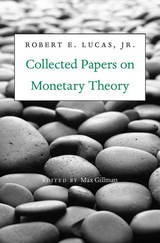 Collected Papers on Monetary Theory
Robert E. Lucas Jr.
Harvard University Press, 2012 Robert Lucas is one of the outstanding monetary theorists of the past hundred years. Along with Knut Wicksell, Irving Fisher, John Maynard Keynes, James Tobin, and Milton Friedman (his teacher), Lucas revolutionized our understanding of how money interacts with the real economy of production, consumption, and exchange.
Lucas’s contributions are both methodological and substantive. Methodologically, he developed dynamic, stochastic, general equilibrium models to analyze economic decision-makers operating through time in a complex, probabilistic environment. Substantively, he incorporated the quantity theory of money into these models and derived its implications for money growth, inflation, and interest rates in the long run. He also showed the different effects of anticipated and unanticipated changes in the stock of money on economic fluctuations, and helped to demonstrate that there was not a long-run trade-off between unemployment and inflation (the Phillips curve) that policy-makers could exploit.
The twenty-one papers collected in this volume fall primarily into three categories: core monetary theory and public finance, asset pricing, and the real effects of monetary instability. Published between 1972 and 2007, they will inspire students and researchers who want to study the work of a master of economic modeling and to advance economics as a pure and applied science.
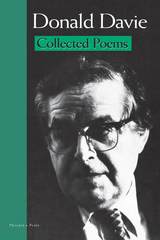 Collected Poems
Donald Davie
University of Chicago Press, 1991 Donald Davie's poems are here arranged chronologically from the 1950s to the beginning of the 1990s. Taken together, the poems display that reverence for the distinctive qualities of the English language which has earned him a name as one of Britain's finest living poets.
"Davie's voice—judgemental, ironic, epigrammatic, humorous, self-lacerating—speaks always with reference to an unhuman perpendicular standard that itself goes unquestioned. It is not a standard of Beauty or Truth; Davie is a poet of the third member of the Platonic triad, Justice."—Helen Vendler, The New Yorker
"[Davie's poems] are on the quiet side, often casual and musing in mood and tone; determined to resist large gestures of assent or denial. . .Donald Davie may just be the best English poet-critic of our time."—William Pritchard, The New Republic
"Donald Davie's Collected Poems does more than mark the culmination of one of the most distinguished careers in post-war British poetry; it is the autobiographical journey of a living poet at the height of his creative powers and the mastery of his craft. Davie is considered the most important and valuable contemporary link between poetry in England and America."—Sarah E. McNeil, Little Rock Free Press
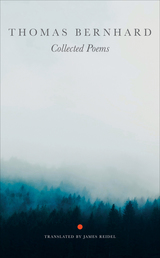 Collected Poems
Thomas Bernhard
Seagull Books, 2017 Bernhard’s Collected Poem is a key to understanding Bernhard’s irascible black comedy found in virtually all of his writings—even down to his last will and testament.
Beloved Austrian writer Thomas Bernhard (1931–89) began his career in the early 1950s as a poet. Over the next decade, Bernhard wrote thousands of poems and published four volumes of intensely wrought and increasingly personal verse, with such titles as On Earth and in Hell, In Hora Mortis, and Under the Iron of the Moon. Bernhard’s early poetry, bearing the influence of Georg Trakl, begins with a deep connection to his Austrian homeland. As his poems saw publication and recognition, Bernhard seemed always on the verge of joining the ranks of Ingeborg Bachmann, Paul Celan, and other young post-war poets writing in German. During this time, however, his poems became increasingly more obsessive, filled with undulant self-pity, counterpointed by a defamatory, bardic voice utterly estranged from his country, all of which resulted in a magisterial work of anti-poetry—one that represents Bernhard’s own harrowing experience with his leitmotif of success and failure, which makes his fiction such a pleasure. There is much to be found in these pages for Bernhard fans of every stripe.
Collected Poems
Edwin Rolfe
University of Illinois Press, 1993 Edwin Rolfe (1909-54) is best known as the poet laureate of the Abraham
Lincoln Battalion, the Americans who volunteered to help defend the elected
Spanish government during its 1936-39 civil war. His career began in the
revolutionary Left in New York in the 1920s and continued into the 1950s,
when Rolfe wrote searing poetry attacking the McCarthy-era witch-hunts.
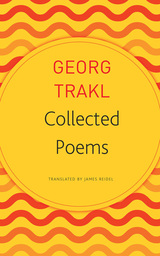 Collected Poems
Georg Trakl
Seagull Books, 2019 The work of poet Georg Trakl, a leading Austrian-German expressionist, has been praised by many, including his contemporaries Rainer Maria Rilke and Else Lasker-Schüler, as well as his patron Ludwig Wittgenstein, who famously wrote that while he did not truly understand Trakl’s poems, they had the tone of a “truly ingenious person,” which pleased him. This difficulty in understanding Trakl’s poems is not unique. Since the first publication of his work in 1913, there has been endless discussion about how the verses should be understood, leading to controversies over the most accurate way to translate them.
In a refreshing contrast to previous translated collections of Trakl’s work, James Reidel is mindful of how the poet himself wished to be read, emphasizing the order and content of the verses to achieve a musical effect. Trakl’s verses were also marked by allegiance to both the nineteenth and twentieth centuries, a fact which Reidel honors with impressive research into the historicity of the poet’s language.
Collected Poems gathers Trakl’s early, middle, and late work, ranging widely, from his haunting prose pieces to his darkly beautiful poems documenting the first bloody weeks of World War I on the Eastern Front.
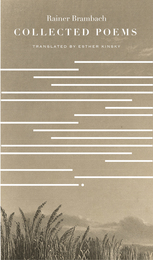 Collected Poems
Rainer Brambach
Seagull Books, 2014 Rainer Brambach, one of the most widely appreciated Swiss poets in the 1950s and '60s, was notorious for walking to the beat of his own drum, denying convention and standing his ground against popular styles and trends. He grew up in Basel and left school at the age of fourteen to become a manual laborer. He spent much of World War II in prison and in labor camps, an experience which greatly influenced his writing. After the war, Brambach began to make his name as a poet. Recognition and awards notwithstanding, Brambach remained an outsider in the literary world and lived for many years in poverty.
Marked by his disregard for material values, a profound engagement with the landscape of the Upper Rhine, and a lasting commitment to humanity, Brambach’s poems are direct, unadorned, and free of pomp or ideology. His quiet images conjure up landscapes, small rural scenes, and interiors of bars and cafes. Brambach was, above all, an observer whose poems provide insights of deceptive simplicity that form a poetic essence confirming the significance of this author’s voice. This collection of poems, masterfully translated by noted writer and poet Esther Kinsky, represents the first major English translation of a significant European poet.
Collected Poems, 1936-1976
Robert Francis
University of Massachusetts Press, 1976 Gathered here in their entirety are the seven previous volumes of Robert Francis poetry — Stand with Me Here, Valhalla and Other Poems, The Sound I Listened For, The Face against the Glass, The Orb Weaver, Come Out into the Sun, and Like Ghosts of Eagles — together with a group of recent poems, many not previously published but "saved" to end this volume on a note of newness.
Because the original seven volumes are kept in chronological order, the reader can follow the author's journey from his quiet early work to poetry of greater color, warmth, vitality, vivacity, and sportiveness; and can note just when and where Francis' style becomes more and more diversified, with word-count, fragmented surface, and the celebration of words themselves.
The book is graced with eight wood engravings by Wang Hui-Ming.
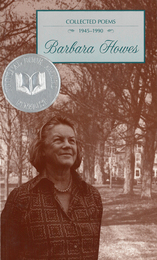 Collected Poems, 1945-1990
Barbara Howes
University of Arkansas Press, 1995 Finalist, 1995 National Book Award This collection fills in a missing chapter in the history of American women’s poetry by bringing a significant voice back into print. Barbara Howes has perfected a personal style that had little to do with the fashionable currents of her time. Dana Gioia has said of her “[O]ne sees Howes very clearly as a woman writing in one of the oddest but most important traditions of American poetry. She stands with Marianne Moore, Elizabeth Bishop, and ultimately Emily Dickinson in a lineage of women writers passionately committed to the independence and singularity of the poetic imagination. Collected poems 1945-1990 contains the lifework of one of America’s irreplaceable poets.” Forty years ago in The New Yorker Louise Bogan wrote: “Barbara Howes is the most accomplished women poet of the younger writing generation—one who has found her own voice, chosen her own material, and worked out her own form. Miss Howes is daring with language, but she is also accurate. Her originality stands in constant close reference to the material in hand, and although much of that material is fantastic or exotic, it is never so simply for its own sake.” Drawing from seven previous books, this collection confirms and consolidates the reputation of Barbara Howes as a timeless poet whose fine voice and surprising insights will continue to delight all lovers of language.
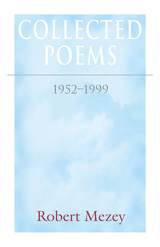 Collected Poems, 1952–1999
Robert Mezey
University of Arkansas Press, 2000 This important collection of poems, which spans a career of nearly fifty years, demonstrates Robert Mezey's development as a notable stylist, thinker, and poet. Moving from adaptations of Latin and Spanish poems to prayers and lamentations, from elegies and plaints of lost love to flights of comic and ribald fancy, his poetry reaches to the extremes of human experience. The death of friends and family, one's self-betrayals and self-infatuations, the comical confusion of a worried mother, the art of a doomed Jewish child in a Nazi concentration camp—all these human dramas play out bravely against the backdrop of the beautiful, indifferent path. Mezey can portray aging and death or sing of love and nature with an accuracy of perception and an intensity of feeling heightened by formal clarity and restraint. With his razor-sharp eye for the singular detail, he describes missed opportunities and moments of human weakness and loss in gestures so real the reader will ache. In capturing the pain of religious doubt, the pangs of tenderness and elation, and the vagaries of fate so honestly, Mezey has wrought a high finish to each poem so that, in the words of Donald Justice, they become "absolute classics of calm and beauty."
 Collected Poems 1953 1994
Ernest Sandeen
University of Notre Dame Press, 2001 "The poems of Ernest Sandeen among other things record not only a writing life but a life in writing: a history of the hours when reflection turns to discovery, and observation finds its fulfillment in the rhythms of a sentence, the weaving of consonants through a line, in pursuit of a mystery. Few poets have been blessed with the gift to sustain that process of meditation, composing, and questioning so consistently, and for so long, in works that are clear-eyed, passionate, and precise." —Robert Pinsky, from the Foreword
During his long tenure in the English department of the University of Notre Dame, Ernest Sandeen published widely. His first published poem, Parked Car, appeared in the New Yorker in 1938. After that, his poems appeared in major reviews, journals, and magazines. They were also collected in six volumes: Antennas of Silence (1953), Children and Older Strangers (1962), Like Any Road Anywhere (1976), Collected Poems: 1953-1977 (1977), A Later Day, Another Year (1989), and Can These Bones Live? (1994). Collected Poems 1953-1994 is a comprehensive collection, representing the best of Sandeen’s previous six volumes—the poems he wished to preserve.
Ernest Sandeen spent virtually his entire life in the century’s poetically generated culture. A contemporary of well-known poets such as W. H. Auden, Gwendolyn Brooks, and Robert Bly, Sandeen’s first literary influence was Carl Sandburg, with whom he shared the hometown of Galesburg, Illinois. Taken together, the poems in this new and augmented volume demonstrate what many discerning readers have always known—that Ernest Sandeen was one of the best poets of his generation, who also deeply influenced many contemporary poets. On the occasion of Sandeen’s death in 1997, former Poet Laureate Robert Hass said in an interview, “what I love about [Sandeen’s] poetry is the way it has a sort of sweet gravity to it that makes you feel that the poet was a genuinely wise man. You feel that in his craft as much as in anything else, that the poem says what it needs to say, so that not needing to show off is a form of beauty. There is a kind of seriousness and grace.”
 Collected Poems 1953-1983
Lucien Stryk
Ohio University Press, 1985 Lucien Stryk’s poetry is made of simple things — frost on a windowpane at morning, ducks moving across a pond, a neighbor’s fuss over his lawn — set into language that is at once direct and powerful.
Years of translating Zen poems and religious texts have helped give Stryk a special sense of the particular, a feel for those details which, because they are so much a part of our lives, seem to define us. Stryk’s poetry is neither an attempt to surpass these details nor an attempt to give them significance. It is an activity that exists among them, as ordinary — yet as important — as breath. Stryk’s poetic power rests in the sureness of plain speech and his insistence on a direct, sympathetic attention to the world we actually inhabit.
Collected Poems, a gathering of three decades of work, contains nearly all Stryk’s poems, including the best of his Zen translations and a book–length section of new poetry. This book is a revelation of the wonderful amid the familiar by a poet whose language and vision have found their maturity.
The Collected Poems and Selected Prose
By Stanley Burnshaw
University of Texas Press, 2002 Stanley Burnshaw began to publish poems in the 1920s and founded his own verse journal in 1925. After serving as coeditor and drama critic of the New Masses weekly (1934-1936), he entered book publishing, directing the Dryden Press until 1958, when he joined Henry Holt. The first of his nineteen earlier works, André Spire and His Poetry, appeared in 1934 and the last in 1990, A Stanley Burnshaw Reader, with an introduction by Denis Donoghue. The present volume—the definitive Burnshaw collection—offers all the poems he wishes to preserve and a full representation of his prose, including My Friend, My Father in its entirety. The Collected Poems and Selected Prose is vital reading for anyone wishing to be fully acquainted with the man whom Karl Shapiro called "one of the best-respected men of letters of our time."
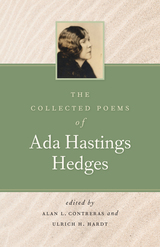 The Collected Poems of Ada Hastings Hedges
Ada Hastings Hedges
Oregon State University Press, 2020 Although for the most part forgotten today, Ada Hastings Hedges was among Oregon’s foremost mid–twentieth-century poets. Famous in her lifetime, she was best known for her superb poems set in Oregon’s high desert, which offer a fascinating counterpoint to C.E.S. Wood’s seminal The Poet in the Desert.
Except for a twelve-year sojourn in southeastern Oregon and two years in Los Angeles, Hedges lived in Portland from 1910 until her death in 1980. She was assistant editor at Binfords & Mort Publishers and a supervising editor in the Works Progress Administration. She taught briefly at Warner Pacific College in the 1960s.
Hedges wrote in a style notable for precision, clarity, and smoothness of line. More than half of her poems in this collection are sonnets. A poet of the city as well as the desert, her work offers a compelling perspective on mid-century Portland life. In 1933 she published her only book, Desert Poems. That collection is reprinted here in its entirety, along with scores of additional poems published in a wide variety of venues, making this the first comprehensive collection of Hedges’s work.
A detailed introduction by the editors and annotations to the text provide information about revisions, publication dates, and notable features. Also included is an essay by Hedges asking “Can Poetry Be Taught?” In her afterword, Oregon poet Ingrid Wendt writes of her admiration for Hedges’s “fierceness of spirit, lack of sentimentality, and complex vision.”
For readers interested in women’s literature, Pacific Northwest poetry, and the literature of Eastern Oregon, this volume reintroduces a compelling regional voice.
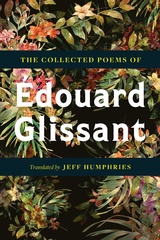 The Collected Poems Of Édouard Glissant
Édouard Glissant
University of Minnesota Press, 2019 The complete poems of the two-time finalist for the Nobel Prize in Literature, available in English for the first time
This volume collects and translates—most for the first time—the nine volumes of poetry published by Édouard Glissant, a poet, novelist, and critic increasingly recognized as one of the great writers of the twentieth century. The poems bring to life what Glissant calls “an archipelago-like reality,” partaking of the exchanges between Europe and its former colonies, between humans and their geographies, between the poet and the natural world. Reciting and re-creating histories of the African diaspora, Columbus’s “discovery” of the New World, the slave trade, and the West Indies, Glissant underscores the role of poetic language in changing both past and present irrevocably. As translator Jeff Humphries writes in his introduction, Glissant’s poetry embraces the aesthetic creed of the French symbolists Mallarmé and Rimbaud (“The poet must make himself into a seer”) and aims at nothing less than a hallucinatory experience of imagination in which the differences among poem, reader, and subject dissolve into one immediate present. Born in Martinique in 1928, influenced by the controversial Martinican poet/politician Aimé Césaire, and educated at the Sorbonne in Paris, Édouard Glissant has emerged as one of the most influential postcolonial theorists, novelists, playwrights, and poets not only in the Caribbean but also in contemporary French letters. He has twice been a finalist for the Nobel Prize in Literature as well as the recipient of both the Prix Renaudot and the Prix Charles Veillon in France. His works include Poetics of Relation, Caribbean Discourse, Faulkner Mississippi, and the novel The Ripening. He currently serves as Distinguished Professor of French at City University of New York, Graduate Center.
 Collected Poems of Hazel Hall, The
Hazel Hall
Oregon State University Press, 2020 On the 100th anniversary of her debut poetry collection, Curtains, first published in 1920, Hazel Hall’s reputation as a major Oregon poet endures. During her short career, she became one of the West’s outstanding literary figures, a poet whose fierce, crystalline verse was frequently compared with that of Emily Dickinson. Her three books, published to critical acclaim in the 1920s, are reissued here in paperback for the first time. Together, they reintroduce an immediate and intensely honest voice, one that speaks to us with an edgy modernity.
Confined to a wheelchair since childhood, Hall viewed life from the window of an upper room in her family’s house in Portland, Oregon. To better observe passersby on the sidewalk, she positioned a small mirror on her windowsill. Hall was an accomplished seamstress; her fine needlework helped to support the family and provided a vivid body of imagery for her precisely crafted, often gorgeously embellished poems.
Hall’s writings convey the dark undertones of the lives of working women in the early twentieth century, while bringing into focus her own private, reclusive life—her limited mobility, her isolation and loneliness, her gifts with needlework and words. In his updated introduction to this volume, John Witte examines Hall’s brief and brilliant career and highlights her remarkably modern sensibilities. In a new afterword, Anita Helle considers Hall’s work in an era when modes of literary historical recovery have been widened and expanded—and what that means in the afterlife of Hazel Hall.
Collected Poems of Howard Nemerov
Howard Nemerov
University of Chicago Press, 1981 The former Poet Laureate of the United States, Nemerov gives us a lucid and precise twist on the commonplaces of everyday life.
The Collected Poems of Howard Nemerov won both the National Book Award and the Pulitzer Prize in 1978.
"Howard Nemerov is a witty, urbane, thoughtful poet, grounded in the classics, a master of the craft. It is refreshing to read his work. . . . "—Minneapolis Tribune
"The world causes in Nemerov a mingled revulsion and love, and a hopeless hope is the most attractive quality in his poems, which slowly turn obverse to reverse, seeing the permanence of change, the vices of virtue, the evanescence of solidities and the errors of truth."—Helen Vendler, New York Times Book Review
The Collected Poems of John Ciardi
John Ciardi
University of Arkansas Press, 1997 From twenty books of verse published between 1940 and 1993, John Ciardi gives us poems of love written with care and honest discernment and poems that tellingly render the ritual dance of human life and mortality.
Collected Poems Of Muriel Rukeyser
Kaufman, Janet E.
University of Pittsburgh Press, 2006
Muriel Rukeyser held a visionary belief in the human capacity to create social change through language. She earned an international reputation as a powerful voice against enforced silences of all kind, against the violence of war, poverty, and racism. Her eloquent poetry of witness-of the Scottsboro Nine, the Spanish Civil War, the poisoning of the Gauley Bridge laborers-split the darkness covering a shameful world.
In addition to the complete texts of her twelve previously published books, this volume also features new poems discovered by the editors; Rukeyser's translations, including the first English translations of Octavio Paz's work; early work by Rukeyser not previously published in book form; and the controversial book-length poem Wake Island. An introduction by the editors traces Rukeyser's life and literary reputation and complements discerning annotations and textual notes to the poems.
The Collected Poems of Sterling A. Brown
Sterling A. Brown
Northwestern University Press, 1996 Arguably the greatest African American poet of the century, Sterling Brown was instrumental in bringing the traditions of African American folk life to readers all over the world. This is the definitive collection of Brown's poems, and the only edition available in the United States.
The Collected Poems of Sterling A. Brown
Sterling A. Brown; Edited by Michael S. Harper; With a New Foreword by Cornelius Eady
Northwestern University Press, 2020 Sterling A. Brown was renowned for his trenchant poetry and scholarship on African American folklife. A contemporary of Langston Hughes, Claude McKay, and Jean Toomer, Brown became the first poet laureate of the District of Columbia. His celebrated works, including Southern Road, address issues of race through collages of narrative and dialect unique to Brown’s unflinching poetic voice.
Edited by the late distinguished poet Michael S. Harper, this classic collection includes a new foreword by award-winning poet Cornelius Eady and the original introduction by Michael S. Harper, as well as introductions to Southern Road by James Weldon Johnson and Sterling Stuckey. The result is a tour de force by one of the most distinctive poets in American letters.
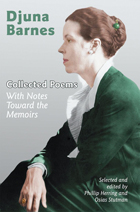 Collected Poems: With Notes Toward the Memoirs
Djuna Barnes; selected and edited by Phillip Herrring and Osias Stutman
University of Wisconsin Press, 2005
This groundbreaking edition compiles many of the late unpublished works of American writer Djuna Barnes (1892–1982). Because she published only seven poems and a play during the last forty years of her life, scholars believed Barnes wrote almost nothing during this period. But at the time of her death her apartment was filled with multiple drafts of unpublished poetry and notes toward her memoirs, both included here for the first time. Best known for her tragic lesbian novel Nightwood, Barnes has always been considered a crucial modernist. Her later poetry will only enhance this reputation as it shows her remarkable evolution from a competent young writer to a deeply intellectual poet in the metaphysical tradition. With the full force of her biting wit and dramatic flair, Barnes’s autobiographical notes describe the expatriate scene in Paris during the 1920s, including her interactions with James Joyce and Gertrude Stein and her intimate recollections of T. S. Eliot. These memoirs provide a rare opportunity to experience the intense personality of this complex and fascinating poet.
Collected Prose
James Wright
University of Michigan Press, 1983 A collection of Wright's essays on the language of poetry
Collected Prose
Robert Hayden
University of Michigan Press, 1984 "A collection of essays on poetry and the experiences that influenced poet Robert Hayden. Contents include "The History of Punchinello: A Baroque Play in One Act," Hayden's introductory remarks to volumes like Kaleidoscope: Poems by American Negro Poet and The New Negro, and interviews with Hayden."
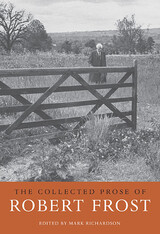 The Collected Prose of Robert Frost
Robert Frost
Harvard University Press, 2009 During his lifetime, Robert Frost notoriously resisted collecting his prose--going so far as to halt the publication of one prepared compilation and to "lose" the transcripts of the Charles Eliot Norton Lectures he delivered at Harvard in 1936. But for all his qualms, Frost conceded to his son that "you can say a lot in prose that verse won't let you say," and that the prose he had written had in fact "made good competition for [his] verse." This volume, the first critical edition of Robert Frost's prose, allows readers and scholars to appreciate the great American author's forays beyond poetry, and to discover in the prose that he did make public--in newspapers, magazines, journals, speeches, and books--the wit, force, and grace that made his poetry famous.
The Collected Prose of Robert Frost offers an extensive and illuminating body of work, ranging from juvenilia--Frost's contributions to his high school Bulletin--to the charming "chicken stories" he wrote as a young family man for The Eastern Poultryman and Farm Poultry, to such famous essays as "The Figure a Poem Makes" and the speeches and contributions to magazines solicited when he had become the Grand Old Man of American letters. Gathered, annotated, and cross-referenced by Mark Richardson, the collection is based on extensive work in archives of Frost's manuscripts. It provides detailed notes on the author's habits of composition and on important textual issues and includes much previously unpublished material. It is a book of boundless appeal and importance, one that should find a home on the bookshelf of anyone interested in Frost.
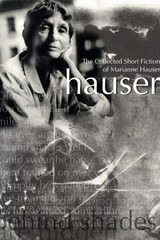 The Collected Short Fiction of Marianne Hauser
Marianne Hauser
University of Alabama Press, 2005 Marianne Hauser's short fiction is a literary documentary of exile, the other-worldly travelogue of an imagination permanently displaced. These accounts of expatriates and lost children situate us in foreign realms, between the titillating intimacies of strangers and looming brutalities we can never quite see. In Hauser's fiction, expatriation is not a historical accident but a condition as essential to humans as breathing or speech. A young boy's suicide in "Heartlands Beat" or a child's vision of her piano teacher's corpse invoke the permanent dislocations that adulthood can never overcome. It is as though birth were, for Hauser, the great forced migration, an incomprehensible banishment from some homeland every child can remember. Her characters gaze in bewilderment at the crude and violent landscape that, through preposterous twistings, they have come to occupy, wondering how they could have ended so incongruously, unable to imagine any dwelling but here. Beautiful fabrications from the writer about whom Anais Nin remarked, "She deftly weaves the strange, the unknown, the unfamiliar, the perverse, into a fabric of human fallibilities that draws drama and farce close to us."
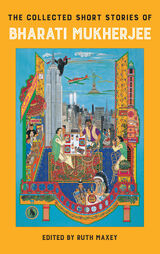 The Collected Short Stories of Bharati Mukherjee
Edited by Ruth Maxey
Temple University Press, 2023 Pioneering Indian American writer Bharati Mukherjee is best known for her novel, Jasmine, and her breakthrough collection, The Middleman and Other Stories, which won the 1988 National Book Critics Circle Award. Her writing is distinguished as much by its narrative style and shifting points of view as it is by Mukherjee’s piercing emotional observations on the immigrant experience and her depiction of racism, nostalgia, and displacement. The Collected Short Stories of Bharati Mukherjee is the first volume to feature the author’s complete short fiction—all 35 stories. Leading Mukherjee scholar Ruth Maxey edits the collection, unearthing seven unknown stories: five in Mukherjee’s unpublished 1963 Iowa Writer’s Workshop M.F.A. thesis, The Shattered Mirror, and two tales from 2008. Arranged chronologically, this essential collection brings many of Mukherjee’s stories back into print, from the semi-autobiographical story, “Hindus,” in her 1985 debut collection, Darkness, to her late stories, published from 1997-2012, as well as her classic, “The Management of Grief.” Maxey contextualizes Mukherjee’s short fiction and the provocative, often prescient political questions it raises about migration, nationhood, class, and history. The Collected Short Stories of Bharati Mukherjee features a Forward by prominent literary studies scholar Nalini Iyer and Afterword by critically acclaimed writer Lysley Tenorio, one of Mukherjee’s former students. It is an essential volume for readers both familiar with Mukherjee’s work and new to her groundbreaking fiction.
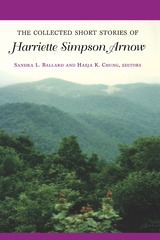 The Collected Short Stories of Harriette Simpson Arnow
Harriette Simpson Arnow
Michigan State University Press, 2005 Harriette Simpson Arnow is an American treasure. Of the twenty-five stories in this collection, fifteen were previously unpublished. Until now, the short fiction of Arnow has remained relatively obscure despite the literary acclaim given to her novels The Dollmaker and Hunter’s Horn. These stories, written early in her career for the most part, reveal an artistic vision and narrative skill and serve as harbingers for her later work. They echo her interest in both agrarian and urban communities, the sharpening of her social conscience, and her commitment to creating credible and complex characters. This collection is organized against the backdrop of her life, from Kentucky in the 1920s to Ohio and Kentucky in the 1930s and to Michigan in the 1940s. As Arnow fans read these early gems, they will be led from gravel roads to city pavement and open layers of Arnow’s development as a novelist to expose the full range of her contributions to American literature.
In 1938, Esquire purchased "The Hunters," which was eventually published as "The Two Hunters," a chilling story of a seventeen-year- old boy’s confrontation with a deputy sheriff. At the time, Esquire did not accept submissions from women, and its editors had no idea that writer H. L. Simpson was not a man. Years later, she admitted in an interview, "it worried me a little, that big lie, but I thought if they wanted a story, let them have it." Esquire paid her $125 for this story. The contributor’s notes at the back of the magazine include a photo of "H.L.Simpson," actually a photo of one of her brothers-in-law. It was her little joke on a publisher that discriminated against women....
—from the Introduction
Collected Shorter Poems
John Peck
Northwestern University Press, 2004 A selection of poems by a contemporary master
John Peck's poems draw on both modernist and traditional resources, quarrying in the large gaps among contemporary readers of poetry. This definitive collection makes available difficult-to-find works by a remarkable, thoroughly original American poet. Peck's poems continue to attract a discerning, loyal audience of readers up to the challenge of confronting his astonishing range and ambitions.
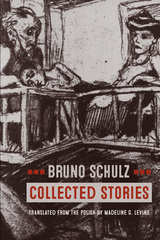 Collected Stories
Bruno Schulz, Translated from the Polish by Madeline G. Levine Foreword by Rivka Galchen
Northwestern University Press, 2018 Winner of the 2019 Found in Translation Award
Collected Stories is an authoritative new translation of the complete fiction of Bruno Schulz, whose work has influenced writers as various as Salman Rushdie, Cynthia Ozick, Jonathan Safran Foer, Philip Roth, Danilo Kiš, and Roberto Bolaño.
Schulz’s prose is renowned for its originality. Set largely in a fictional counterpart of his hometown of Drohobych, his stories merge the real and the surreal. The most ordinary objects—the wind, an article of clothing, a plate of fish—can suddenly appear unfathomably mysterious and capable of illuminating profound truths. As Father, one of his most intriguing characters, declaims: “Matter has been granted infinite fecundity, an inexhaustible vital force, and at the same time, a seductive power of temptation that entices us to create forms.”
This comprehensive volume brings together all of Schulz's published stories—Cinnamon Shops, his most famous collection (sometimes titled The Street of Crocodiles in English), The Sanatorium under the Hourglass, and an additional four stories that he did not include in either of his collections. Madeline G. Levine’s masterful new translation shows contemporary readers how Schulz, often compared to Proust and Kafka, reveals the workings of memory and consciousness.
Collected Studies in Pre-Columbian Art and Archaeology, Nos. 12, 13, 14
Johannes Wilbert, Peter G. Roe, and Elizabeth P. Benson
Harvard University Press This volume contains three monographs from the series of Collected Studies in Pre-Columbian Art and Archeology. Johannes Wilbert looks at the use and decoration of spindles, focusing on those from Ecuador. Peter Roe examines the Chavin seriations, with numerous illustrations and a pullout chart, and Elizabeth Benson considers the motif of felines and men in Mochica art.
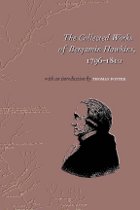 The Collected Works of Benjamin Hawkins, 1796–1810
Benjamin Hawkins, edited and with an introduction by H. Thomas Foster, II
University of Alabama Press, 2003 A comprehensive collection of the most important sources on the late historic Creek Indians and their environment
In 1795 Benjamin Hawkins, a former US senator and advisor to George Washington, was appointed US Indian agent and superintendent of all the tribes south of the Ohio River. Unlike most other agents, he lived among the Creek Indians for his entire tenure, from 1796 to 1816. Journeying forth from his home on the Flint River in Georgia, he served southeastern Indians as government intermediary during one of the longest eras of peace in the historic period.
Hawkins’s journals provide detailed information about European-Indian relations in the 18th-century frontier of the South. His descriptions of the natural and cultural environment are considered among the best sources for the ethnohistory of the Choctaw, Cherokee, Chickasaw, and, especially, the Creek Indians and the natural history of their territory.
Two previously published bodies of work by Benjamin Hawkins are included here—A Sketch of the Creek Country in the Years 1798 and 1799 and The Letters of Benjamin Hawkins 1796-1806. A third body of work that has never been published, “A Viatory or Journal of Distances” (describing routes and distances of a 3,578-mile journey through parts of Georgia, Alabama, and Mississippi), has been added. Together, these documents make up the known body of Hawkins’ work—his talks, treaties, correspondence, aboriginal vocabularies, travel journals, and records of the manners, customs, rites, and civil polity of the tribes. Hawkins' work provides an invaluable record of the time period.
 The Collected Works of Count Rumford
Count Rumford
Harvard University Press An American of wide-ranging interests and overflowing energy, Benjamin Thompson applied his scientific and technical knowledge to the improvement of public service and welfare institutions in Bavaria (a service for which he was made Count Rumford), Ireland, England, and Italy. In the process, he made important discoveries in physics. In this new edition of Rumford's Works, Sanborn Brown has arranged his writings according to subject matter: this first volume contains his papers on the nature of heat, and includes one paper which has never before been published in English.
The volume begins with Rumford's paper on the production of heat by friction, and continues with descriptions of the experiments by which he showed that heat has no weight, and his essays on the propagation of heat in solids and fluids. Subsequent volumes contain papers on practical applications of heat, devices and techniques (including studies of fireplaces and chimneys), armament, light and color, and on such public establishments and organizations as poorhouses, the army of Bavaria, and the Royal Institution in London.
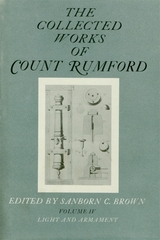 The Collected Works of Count Rumford
Count Rumford
Harvard University Press Like his countryman and contemporary Benjamin Franklin, Benjamin Thompson (later Count Rumford) aimed by his inventions and scientific research to increase the degree of comfort in daily life. During fourteen years spent in Munich, he made important reforms in the city's public service and social welfare institutions; he also introduced improvements in the hospitals and workhouses in Ireland, England, and Italy. His goals were practical, and his contributions to our knowledge of the nature of heat were as valuable as Franklin's to our knowledge of electricity. Rumford believed heat to be a form of energy, and worked to demolish the widely held material theory of heat.
Between 1870 and 1875 the American Academy of Arts and Sciences in Boston published Rumford's “complete” Works, financing the project with part of the increase of a fund that Rumford himself had given to the Academy in 1796. This edition presented, in order of their first appearance, all the papers that the Academy committee was able to find. The Academy edition has long been out of print and practically unavailable.
In this edition Sanborn Brown has rearranged the papers according to subject matter. Rumford's papers dealing with light and with armament are contained in this fourth volume. They include “Intensity of Light”; “Coloured Shadows”; “Harmony of Colors”; “Chemical Properties of Light”; “Management of Light”; “Source of Light in Combustion”; “Air from Water Exposed to Light”; “Description of a New Lamp”; “Experiments upon Gunpowder”; “Force of Fired Gunpowder”; and “Experiments with Cannon.”
 The Collected Works of Count Rumford
Count Rumford
Harvard University Press, 1968 Benjamin Thompson (later Count Rumford) aimed by his inventions and scientific research to increase the degree of comfort in daily life. His goals were practical and his contributions to our knowledge of the nature of heat proved extremely valuable. Between 1870 and 1875, the American Academy of Arts and Sciences in Boston published all of Rumford's papers that the Academy committee was able to find. The Academy edition, however, has long been out of print and practically unavailable. Here Sanborn Brown has rearranged the papers according to subject matter.
Volume I contains Rumford's papers on the nature of heat; the second covers its practical applications. This third volume contains his papers on devices and techniques, including “Use of Steam for Transporting Heat”; “Means of Heating the Hall of the (French) Institute”; “New Boiler for Saving Fuel”; “Steam Heat for Making Soap”; “Fires in Closed Fire-Places”; “Kitchen Fire-Places”; “Salubrity of Warm Rooms”; “Salubrity of Warm Bathing”; “The Strength of Silk”; “Quantities of Absorbed Moisture”; “Advantage of Wheels with Broad Felloes”; and “Proposals for Building a Frigate.”
 The Collected Works of Count Rumford
Count Rumford
Harvard University Press Like his countryman and contemporary Benjamin Franklin, Benjamin Thompson (later Count Rumford) aimed by his inventions and scientific research to increase the degree of comfort in daily life. During the fourteen years spent in Munich, he made important reforms in the city's public service and social welfare institutions; he also introduced improvements in the hospitals and workhouses in Ireland, England, and Italy. Rumford's contributions to our knowledge of the nature of heat were as valuable as Franklin's to our knowledge of electricity. Volume I of this edition of Rumford's Works contained his papers on the nature of heat. This second volume presents Rumford's work on the practical applications of heat. Of particular interest are his papers on the propagation of heat in liquids, chimney fire-places, supplementary observations on chimney fire-places, and the management of fire and the economy of fuel. Subsequent volumes contain papers on devices and techniques, light and armament, and public institutions.
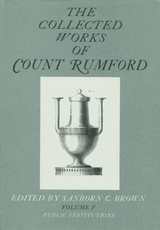 The Collected Works of Count Rumford
Count Rumford
Harvard University Press An American of wide-ranging interests and overflowing energy, Benjamin Thompson applied his scientific and technical knowledge to the improvement of public service and welfare institutions in Bavaria (a service for which he was made Count Rumford), Ireland, England, and Italy. In the process, he made important discoveries in physics. In this new edition of Rumford’s Works, Sanborn Brown has arranged his writings according to subject matter: in this fifth volume are Rumford’s papers on public institutions: “Poor in Munich”; “Poor in All Countries”; “Feeding the Poor”; “Coffee”; “Public Institutions in Bavaria”; “Regulations for the Army of Bavaria”; “Public Institutions in Great Britain”; and “The Royal Institution.”
The Collected Works of Count Rumford is much more than a source book or a guide to methods of research in physics. It provides a unique portrait of the scientific, political, and social conditions of the turbulent early years of the Industrial Revolution.
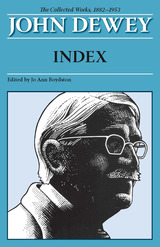 The Collected Works of John Dewey, Index: 1882 - 1953
John Dewey. Edited by Jo Ann Boydston
Southern Illinois University Press, 1991 This cumulative index to the thirty-seven volumes of The Collected Works of John Dewey, 1882–1953, is an invaluable guide to The Collected Works. The Collected Works Contents incorporates all the tables of contents of Dewey’s individual volumes, providing a chronological, volume-by-volume overview of every item in The Early Works, The Middle Works, and The Later Works. The Title Index lists alphabetically by shortened titles and by key words all items in The Collected Works. Articles republished in the collections listed above are also grouped under the titles of those books. The Subject Index, which includes all information in the original volume indexes, expands that information by adding the authors of introductions to each volume, authors and titles of books Dewey reviewed or introduced, authors of appendix items, and relevant details from the source notes.
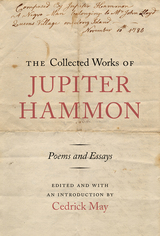 The Collected Works of Jupiter Hammon
Cedrick May
University of Tennessee Press, 2017 “This text will become the definitive collection of Hammon’s work—not only because of the archival finds that Cedrick May features but also because of his careful and attentive reconstruction of Hammon’s historical, political, social, and religious contexts.”—Katy L. Chiles, author of Transformable Race: Surprising Metamorphoses in the Literature of Early America
Cedrick May’s The Collected Works of Jupiter Hammon offers a complete look at the literary achievements of one of the founders of African American literature. Born into slavery on the Lloyd plantation in 1711, Jupiter Hammon became the first African American writer to be published in the present-day United States at the age of forty-nine. It has been decades since a collection of Hammon’s work has appeared, and May’s intensive research has yielded two additional poems, adding new layers to his works and life that, until now, have gone unexplored.
The most comprehensive volume on Hammon’s works to date, The Collected Works of Jupiter Hammon carefully reconstructs the historical, political, social, and religious contexts that shaped his essays and poems throughout the late eighteenth century. This attentive reconstruction, which takes full account of Hammon’s prose works as well as his more well-known poetry, gives readers a radical re-reading of Hammon as a much more complex and intellectually curious commentator on his historical and political period, while providing ample evidence of his literary importance and artistic integrity. Cedrick May’s fresh presentation and insightful reevaluation of Hammon’s life and writings will change the way Hammon is studied and appreciated among literary scholars and readers alike. This edition will become the definitive one for many years to come.
CEDRICK MAY is Professor of English & Digital Arts at The University of Texas at Arlington. He is the author of Evangelism and Resistance in the Black Atlantic, 1760–1835 (2008). His articles and essays have appeared in African American Review, EAL: Early American Literature, and A History of African American Autobiography (2021).
 The Collected Works of Jupiter Hammon
Cedrick May
University of Tennessee Press, 2016 “This text will become the definitive collection of Hammon’s work—not only because of the archival finds that Cedrick May features but also because of his careful and attentive reconstruction of Hammon’s historical, political, social, and religious contexts.”—Katy L. Chiles, author of Transformable Race: Surprising Metamorphoses in the Literature of Early America
Cedrick May’s The Collected Works of Jupiter Hammon offers a complete look at the literary achievements of one of the founders of African American literature. Born into slavery on the Lloyd plantation in 1711, Jupiter Hammon became the first African American writer to be published in the present-day United States at the age of forty-nine. It has been decades since a collection of Hammon’s work has appeared, and May’s intensive research has yielded two additional poems, adding new layers to his works and life that, until now, have gone unexplored.
The most comprehensive volume on Hammon’s works to date, The Collected Works of Jupiter Hammon carefully reconstructs the historical, political, social, and religious contexts that shaped his essays and poems throughout the late eighteenth century. This attentive reconstruction, which takes full account of Hammon’s prose works as well as his more well-known poetry, gives readers a radical re-reading of Hammon as a much more complex and intellectually curious commentator on his historical and political period, while providing ample evidence of his literary importance and artistic integrity. Cedrick May’s fresh presentation and insightful reevaluation of Hammon’s life and writings will change the way Hammon is studied and appreciated among literary scholars and readers alike. This edition will become the definitive one for many years to come.
CEDRICK MAY is Professor of English & Digital Arts at The University of Texas at Arlington. He is the author of Evangelism and Resistance in the Black Atlantic, 1760–1835 (2008). His articles and essays have appeared in African American Review, EAL: Early American Literature, and A History of African American Autobiography (2021).
Collected Works of Nana Asma'u: Daughter of Usman 'dan Fodiyo (1793-1864)
Jean Boyd
Michigan State University Press, 1997 Nana Asma'u Bint Usman 'dan Fodiyo, a nineteenth-century Muslim scholar, lived in the region now known as northern Nigeria and was an eyewitness to battles of the largest of the West-African jihads of the era. The preparation and conduct of the jihad provide the topics for Nana Asma'u's poetry. Her work also includes treatises on history, law, mysticism, theology, and politics, and was heavily influenced by the Arabic poetic tradition.
This volume contains annotated translations of works by the 19th century intellectual giant, Nana Asma'u, including 54 poems and prose texts. Asma'u rallied public opinion behind a movement devoted to the revival of Islam in West Africa, and organized a public education system for women.
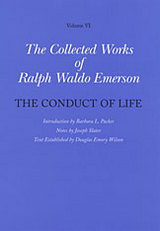 Collected Works of Ralph Waldo Emerson
Historical Introduction by Barbara L. PackerNotes by Joseph SlaterText Established and Textual Introduction and Apparatus by Douglas Emory Wilson
Harvard University Press, 1971 The essays in this book, first published in 1860, were developed from a series of lectures on "The Conduct of Life" delivered by Emerson during the early 1850s. Some of the original lectures were dropped and the rest were considerably revised, with new topics introduced. The published essays, on "Fate," "Power," "Wealth," "Culture," "Behavior," "Worship," "Considerations by the Way," "Beauty," and "Illusions," show Emerson's interest in many practical aspects of human life, and reflect his increasing involvement in politics--chiefly in the antislavery movement--during the decade before the Civil War.
This edition is based on Emerson's holograph manuscripts and published sources. The text incorporates Emerson's later corrections and revisions, and shows us what he actually wrote (or, perhaps in some cases, intended to write).
The historical introduction traces the book's development and its relation to Emerson's own personal growth and political awareness. Joseph Slater's explanatory notes help the modern reader to understand many of Emerson's references and allusions that may not be readily apparent.
Historical Introduction by Barbara L. Packer
Notes by Joseph Slater
Text Established and Textual Introduction and Apparatus by Douglas Emory Wilson
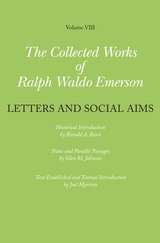 Collected Works of Ralph Waldo Emerson
Historical Introduction by Ronald A. BoscoNotes and Parallel Passages by Glen M. JohnsonTextual Apparatus by Joel Myerson
Harvard University Press, 2010 Letters and Social Aims, published in 1875, contains essays originally published early in the 1840s as well as those that were the product of a collaborative effort among Ralph Waldo Emerson, his daughter Ellen Tucker Emerson, his son Edward Waldo Emerson, and his literary executor James Eliot Cabot. The volume takes up the topics of “Poetry and Imagination,” “Social Aims,” “Eloquence,” “Resources,” “The Comic,” “Quotation and Originality,” “Progress of Culture,” “Persian Poetry,” “Inspiration,” “Greatness,” and, appropriately for Emerson’s last published book, “Immortality.”The historical introduction demonstrates for the first time the decline in Emerson’s creative powers after 1865; the strain caused by the preparation of a poetry anthology and delivery of lectures at Harvard during this time; the devastating effect of a house fire in 1872; and how the Emerson children and Cabot worked together to enable Emerson to complete the book. The textual introduction traces this collaborative process in detail and also provides new information about the genesis of the volume as a response to a proposed unauthorized British edition of Emerson’s works.Historical Introduction by Ronald A. Bosco
Notes and Parallel Passages by Glen M. Johnson
Text Established and Textual Introduction and Apparatus by Joel Myerson
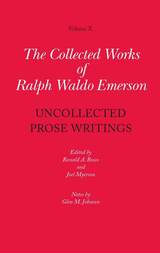 Collected Works of Ralph Waldo Emerson
Ralph Waldo Emerson
Harvard University Press, 1971 With the appearance of the tenth and final volume of Collected Works, a project fifty years in the making reaches completion: the publication of critically edited texts of all of Emerson’s works published in his lifetime and under his supervision. The Uncollected Prose Writings is the definitive gathering of Emerson’s previously published prose writings that he left uncollected at the time of his death.
The Uncollected Prose Writings supersedes the three posthumous volumes of Emerson’s prose that James Elliot Cabot and Edward Waldo Emerson added to his canon. Seeing as their primary task the expansion of the Emerson canon, they embellished and improvised. By contrast, Ronald A. Bosco and Joel Myerson have undertaken the restoration of Emerson’s uncollected prose canon, printing only what Emerson alone wrote, authorized for publication, and saw into print.
In their Historical Introduction and Textual Introduction, the editors survey the sweep of Emerson’s uncollected published prose. The evidence they marshal reveals Emerson’s progressive reliance on lectures as forerunners to his published prose in major periodicals and clarifies what has been a slowly emerging portrait of the last decade and a half of his life as a public intellectual.
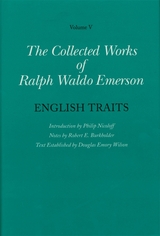 Collected Works of Ralph Waldo Emerson
Ralph Waldo Emerson
Harvard University Press, 1971 Emerson traveled broadly in England and Scotland in 1833 and again on lecture tour fifteen years later. Drawing on his experiences there as well as his wide reading in British history, he set forth in English Traits his view of the English as a nation. Published in 1856, this was one of his most popular books, perhaps because of its playfulness and wit and clarity of style.
English Traits is a searching and distinctive portrayal of English culture that today offers a revealing perspective on American viewpoints and preoccupations in the mid-nineteenth century. It is notable, too, for revealing an interesting side of Emerson's complex character; here we find Emerson the practical Yankee, analyzing English power, resourcefulness, determination, and materialism.
The historical introduction to this fullscale critical edition, places English Traits in the context of Emerson's career and travels, and discusses the book's contemporary reception. The explanatory notes provide a treasury of helpful information. This is the definitive scholarly edition of English Traits.
Historical Introduction by Philip Nicoloff
Notes by Robert E. Burkholder
Text Established and Textual Introduction and Apparatus by Douglas Emory Wilson
 Collected Works of Ralph Waldo Emerson
Ralph Waldo Emerson
Harvard University Press, 1971 In 1849 Ralph Waldo Emerson collected in one volume all of his published work he thought worthy of preservation that had not been contained in the two series of Essays (1841, 1844) and the Poems (1847). Included were the essay Nature (1836); four orations, “The American Scholar,” “The Divinity School Address,” and two others; and five lectures which had appeared in The Dial.
As the first volume of a projected new Collected Works, this edition of Nature, Addresses, and Lectures now provides for the first time a definitive text based on collation of all editions in which Emerson might have had a hand, together with a wholly new introduction and extensive notes. The recently published Journals and Lectures from this period help bring to this volume a fresh perspective on the first and formative stage of Emerson’s career as a public figure and man of letters.
Introduction and Notes by Robert E. Spiller; Text Established by Alfred R. Ferguson
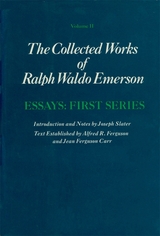 Collected Works of Ralph Waldo Emerson
Ralph Waldo Emerson
Harvard University Press, 1971 Some of Ralph Waldo Emerson’s finest and most famous essays, such as “Self-Reliance,” “Compensation,” and “The Over-Soul,” appeared in his Essays of 1841, published when he was thirty-seven years old. Preceded by the slim volume Nature, it was his first full-length book.
The present edition provides for the first time an authoritative text of the Essays, together with an introduction, notes, and supplementary material of great value for the study of Emerson’s creative processes. A list of hundreds of parallel passages in his earlier journals and lectures makes it possible to examine in detail how he drew upon those manuscripts (now published), especially the voluminous journals, as grist for the twelve essays. His subsequent alterations of the essays, particularly in the revised edition of 1847, give evidence of the evolution of his thought and style at this stage of his career. While the text incorporates his revisions, so as to represent his final intention, the earlier versions are given at the end of the book.
Introduction and Notes by Joseph Slater
Text Established by Alfred R. Ferguson and Jean Ferguson Carr
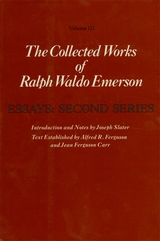 Collected Works of Ralph Waldo Emerson
Ralph Waldo Emerson
Harvard University Press, 1971 Ralph Waldo Emerson’s second collection of essays appeared in 1844, when he was forty-one. It includes eight essays—“The Poet,” “Experience,” “Character,” “Manners,” “Gifts,” “Nature,” “Politics,” and “Nominalist and Realist”—and one address, the much misunderstood “New England Reformers.” Essays: Second Series has a lightness of tone and an irony absent from the earlier writings, but it is no less memorable: “a sermon to me,” Carlyle wrote, “a real word.”
The present edition, drawing on the vast body of Emerson scholarship of the last forty years, incorporates all the textual changes Emerson made or demonstrably intended to make after 1844. It records variant wordings and recounts the development of the text before and after publication. A list of parallel passages makes it possible to trace Emerson’s extensive use of material from his journals, notebooks, and lectures. Endnotes provide information about people, events, and now-obscure terms. A brief historical introduction places the book in the context of the years during which it was written, the time of Brook Farm, The Dial, and the death of Emerson’s five year-old son.
Historical Introduction and Notes by Joseph Slater
Text Established by Alfred R. Ferguson and Jean Ferguson Carr
Textual Introduction and Apparatus by Jean Ferguson Carr
 Collected Works of Ralph Waldo Emerson
Ralph Waldo Emerson
Harvard University Press, 1971 In 1845 Emerson delivered a series of lectures entitled "Uses of Great Men; Plato, or the Philosopher; Swedenborg, or the Mystic; Montaigne, or the Skeptic; Shakespeare, or the Poet; Napoleon, or the Man of the World; and Goethe, or the Writer." Emerson's approach to his great men stands in interesting contrast to that of his friend Carlyle in his Heroes and Hero Worship of 1841.
Although by 1845 Emerson had been lecturing for over ten years, Representative Men, published in 1850, was the first of his works to consist of his lectures as delivered, with only minima! revision and expansion. The book retains the immediacy of the spoken word, and the freedom and daring inspired by a live audience.
This critical edition is based on Emerson's holograph manuscript, which served as printer's copy for the first American edition, collated with subsequent editions and with Emerson's own corrections. The historical introduction relates the book to Emerson's life and times and discusses its literary origins, composition, and contemporary reception. A textual introduction and apparatus have been provided by the textual editor, and there are full informational notes. The volume has been awarded the seal of the Center for Scholarly Editions
Joseph Slater, General Editor
Douglas Emory Wilson, Textual Editor
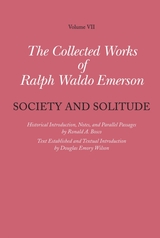 Collected Works of Ralph Waldo Emerson
Ralph Waldo EmersonHistorical Introduction, Notes, and Parallel Passages by Ronald A. BoscoText Established and Textual Introduction by Douglas Emory Wilson
Harvard University Press, 1971 Society and Solitude, published in 1870, was the first collection of essays Emerson had put into press since The Conduct of Life ten years earlier. Of the twelve essays included in the volume, he had previously published seven in whole or in part: "Society and Solitude," "Civilization," "Art," "Eloquence," "Domestic Life," "Books," and "Old Age." Emerson added five previously unpublished lectures or essays, "Works and Days," "Clubs," "Courage," "Success," and "Farming."This edition is based on Emerson's holograph manuscripts and published sources. The text incorporates corrections and revisions he recorded in both sources, and thus restores for the reader the text he actually wrote. Although he is still visibly the insistent optimist of his early and middle career, here Emerson assumes a more pragmatic attitude than formerly toward the life of the mind and the imagination. Society and Solitude captures the penultimate expression of Emersonian Transcendentalism and Romanticism.Historical Introduction, Notes, and Parallel Passages by Ronald A. BoscoText Established and Textual Introduction and Apparatus by Douglas Emory Wilson
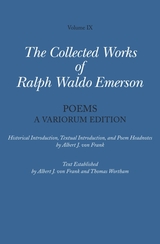 Collected Works of Ralph Waldo Emerson
Ralph Waldo Emerson
Harvard University Press, 1971 At his death in 1882, Ralph Waldo Emerson was counted among the greatest poets in nineteenth-century America. This variorum edition of all the poems Emerson chose for publication during his lifetime offers readers the opportunity to situate Emerson’s poetic achievement alongside his celebrated essays and to consider their interrelationship.
Decades before Walt Whitman and Emily Dickinson took their places in the firmament of American poets, Emerson was securely enthroned. Though his reputation as essayist now eclipses his reputation as poet, Emerson self-identified as a writer of verse and worked out his transcendental philosophy in this genre, establishing his belief in the authority of individual experience and in the essential metaphoric nature of language. Albert J. von Frank’s historical introduction traces the development of Emerson the poet, considering how life events, as well as his reading of German philosophy and Sufi poetry, influenced his thought and expression. Alongside accounts of the critical reception of his poems are public and private writings that reveal Emerson’s own estimation of his poetic project and achievement.
The textual introduction and apparatus make transparent the theoretical and practical concerns that inform these critical texts. Also included are a chronological lists of variants and texts constituting the historical collation, notes clarifying obscure allusions, and headnotes identifying sources and context.
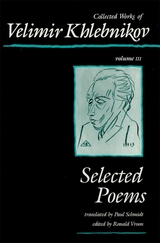 Collected Works of Velimir Khlebnikov
Velimir Khlebnikov
Harvard University Press Dubbed "a Columbus of new poetic continents" because of his search for a poetics as diverse as the universe itself, Velimir Khlebnikov is the creator of some of the most extraordinary poems in the Russian language. Sometimes surreal, sometimes esoteric, but always dazzlingly innovative, the 192 poems in this volume range broadly from the lyrical to the epic.
One of the founders of Russian Futurism, Khlebnikov spent his entire brief life searching for a new poetic language to express his convictions about the rhythm of history and the connection between the truth of a poet's language and the cosmic truth about the universe. His poetry is characterized by often radical experimentation with language and words, a forceful utopian vision, complex theories of time and history, and multiple poetic personae: from an infantry commander to a Carthaginian war hero, from Cleopatra's paramour to the letters of the alphabet. Completing the Collected Works of Velimir Khlebnikov, Selected Poems gives us insight into the imagination of a remarkable artist.
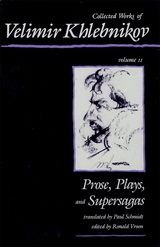 Collected Works of Velimir Khlebnikov
Velimir Khlebnikov
Harvard University Press Velimir Khlebnikov, who died in 1922 at the age of thirty-six, is one of the great innovators of literary modernism. In Russia a powerful and growing mythology surrounds this Futurist poet and his reputation elsewhere continues to mount.
The second volume of the Collected Works consists of Khlebnikov's fiction (thirty-five short stories, dreams, mysteries, and fanciful folktales), his plays, and his unique supersagas, a syncretic genre he created to encompass his iconoclastic view of the world. Paul Schmidt's are the first translations of these works into English. They chronicle the artist's imagination in his feverish search for a poetics that could be as diverse as the universe itself.
The fictions, ranging from the mysterious "Murksong" to the epic "Yasir," show a great variety of styles and themes. But it is in the dramatic text that we best see Khlebnikov's struggle to find a workable form for his vision. The Girl-God, symbolist-inspired, is a mélange of stylistic shifts and impossible scene changes. In The Little Devil, The Marquise des S., and the sardonic Miss Death Makes a Mistakes, Khlebnikov finally finds a stageable theatrical form, in a mixture of satire, colloquial speech, and poetic reflections on art and immortality. The dramatist reaches even higher in the supersagas Otter's Children and Zangezi, achieving a Wagnerian fusion of action, poetry, history, theory, and the musical rhythms of incantation.
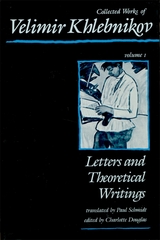 Collected Works of Velimir Khlebnikov
Velimir Khlebnikov
Harvard University Press, 1987 Dubbed by his fellow Futurists the "King of Time," Velimir Khlebnikov (1885-1922) spent his entire brief life searching for a new poetic language to express his convictions about the rhythm of history, the correspondence between human behavior and the "language of the stars." The result was a vast body of poetry and prose that has been called hermetic, incomprehensible, even deranged. Of all this tragic generation of Russian poets (including Blok, Esenin, and Mayakovsky), Khlebnikov has been perhaps the most praised and the more censured.
This first volume of the Collected Works, an edition sponsored by the Dia Art Foundation, will do much to establish the counterimage of Khlebnikov as an honest, serious writer. The 117 letters published here for the first time in English reveal an ebullient, humane, impractical, but deliberate working artist. We read of the continuing involvement with his family throughout his vagabond life (pleas to his smartest sister, Vera, to break out of the mold, pleas to his scholarly father not to condemn and to send a warm overcoat); the naive pleasure he took in being applauded by other artists; his insistence that a young girl's simple verses be included in one of the typically outrageous Futurist publications of the time; his jealous fury at the appearance in Moscow of the Italian Futurist Marinetti; a first draft of his famous zoo poem ("O Garden of Animals!"); his seriocomic but ultimately shattering efforts to be released from army service; his inexhaustibly courageous confrontation with his own disease and excruciating poverty; and always his deadly earnest attempt to make sense of numbers, language, suffering, politics, and the exigencies of publication.
The theoretical writings presented here are even more important than the letters to an understanding of Khlebnikov's creative output. In the scientific articles written before 1910, we discern foreshadowings of major patterns of later poetic work. In the pan-Slavic proclamations of 1908-1914, we find explicit connections between cultural roots and linguistic ramifications. In the semantic excursuses beginning in 1915, we can see Khlebnikov's experiments with consonants, nouns, and definitions spelled out in accessible, if arid, form. The essays of 1916-1922 take us into the future of Planet Earth, visions of universal order and accomplishment that no longer seem so farfetched but indeed resonate for modern readers.
 The Collected Works of William Howard Taft, Volume I: Four Aspects of Civic Duty and Present Day Problems
David H. Burton
Ohio University Press, 2001 The inaugural volume of The Collected Works of William Howard Taft is composed of two of his earliest books, Four Aspects of Civic Duty and Present Day Problems. Based on a series of lectures delivered at Yale in 1906, Four Aspects of Civic Duty is an attempt by then Secretary of War Taft to bring to the attention of his audience the importance of civic duty from the perspective of the university graduate, the judge on the bench, the colonial administrator, and the national executive branch of government. His remarks were drawn from his own experience, while at the same time he laid down the principles of citizenship with which all people could identify. In Present Day Problems, William Howard Taft demonstrates the depth of his knowledge and the seriousness of his reflections on a wide range of topics including Sino-American relations and the ongoing contest between capital and labor in America’s increasingly industrial socioeconomy. The problems he takes up are met head-on and discussed in a fashion likely to persuade his audience that he is well prepared to tackle the burdens of the presidency.
The Collected Works of William Howard Taft, in eight volumes, will include Taft’s complete published works as well as his presidential and state addresses and selected court opinions from his days as chief justice of the Supreme Court.
 The Collected Works of William Howard Taft, Volume II: Political Issues and Outlooks: Speeches Delivered Between August 1908 and February 1909
David H. Burton
Ohio University Press, 2001 The second volume of The Collected Works of William Howard Taft is dedicated to the speeches and writings that displayed his thinking in the autumn of 1908 and the following winter.
At this time he was campaigning for the presidency against the well-known William Jennings Bryan, and in Taft’s writings is evidence of the contrast in style between Taft and Bryan and between Taft and his predecessor, Teddy Roosevelt. as well. Although uncomfortable with campaigning, he thoughtfully addresses the concerns of the day that framed the election, including race, the Philippines, and socialism.
Political Issues and Outlooks also contains speeches made after the election and leading up to his inauguration as the twenty-seventh president of the United States. Introduced by a commentary from the general series editor Professor David H. Burton, the second volume of The Collected Works of William Howard Taft is a revealing look at the machinations of United States politics at the beginning of the twentieth century and a glimpse into the mind of one of the century’s most influential political architects.
 The Collected Works of William Howard Taft, Volume III: Presidential Addresses and State Papers
David H. Burton
Ohio University Press, 2001 The third volume of The Collected Works of William Howard Taft imparts an appreciation of the range of the twenty-seventh president’s interests. Beginning with his inaugural address and concluding with a detailed exposition of governmental expenses and needed economies, President William Howard Taft showed himself willing to tackle the routine as well as the rarified responsibilities of executive rule.
Whether he was addressing the issue of strikes and labor unions or conservation, President Taft consistently demonstrated that, in word and action, he was prepared to be a modern president. What impresses the reader of these remarks is Taft’s willingness to administer to virtually every part of the nation, thereby proving that he was not a mere figurehead but a chief executive truly concerned about problems across the country. Perhaps, as his words here indicate, Taft was not a good politician after all but a kind man who saw himself as president of all the people. As the first of two volumes directly related to Taft’s tenure as president, Presidential Addresses and State Papers documents a pivotal time in the public life of this man from Ohio. Introduced by a commentary from the general series editor Professor David H. Burton, the third volume of The Collected Works of William Howard Taft underscores the presidential stature of William Howard Taft.
 The Collected Works of William Howard Taft, Volume IV: Presidential Messages to Congress
David H. Burton
Ohio University Press, 2002 “A time when panics seem far removed is the best time to prepare our financial system to withstand a storm. The most crying need this country has is a proper banking and currency system. The existing one is inadequate, and everyone who has studied the question admits it.”—William Howard Taft
The interaction between President William Howard Taft and the Congress provides a window on his leadership. Volume IV of The Collected Works of William Howard Taft is devoted to his messages to the legislative branch and concerns some of the pressing issues of the day, issues that have relevance still.
Oftentimes President Taft was at odds with a somewhat reactionary Congress, causing him to veto legislation that he thought unwise. For example, his commitment to the independence of elected judges led him to reject statehood for Arizona until its constitution was altered to address his objection.
His messages also touched on subjects for which he led the way over the objections of Congress, such as his recommendation of a federal law to protect resident aliens against denial of their civil rights and his advocacy of free trade with Canada.
In his commentary to the volume, Professor Burton points out: “There is exhibited time after time concern for the American people, for men and women from different walks of life. Taft comes across less as a judge, which he had been, or the chief justice he was to become, and more as a sitting president of all the people.”
Taft’s Presidential Messages to Congress provides the documentary evidence to support that claim.
 The Collected Works of William Howard Taft, Volume V: Popular Government and The Anti-trust Act and the Supreme Court
David H. Burton
Ohio University Press, 2003 The fifth volume of The Complete Works of William Howard Taft presents two publications Taft wrote as Kent Professor of Constitutional Law at Yale University, the position he assumed in 1913 after he was defeated in his bid for re-election as U.S. president. The first, Popular Government, was prepared for a series of lectures, but was motivated by Taft’s passion over the issue of constitutional interpretation, which had been hotly contested during the campaign. Organized around the preamble of the Constitution, the lectures and later the book were opportunities for Taft to restate his opposition to the direct democracy movement and to reveal the workings of a conservative mind.
In the second, The Anti-trust Act and the Supreme Court, Taft articulates his position in the ongoing debate over the conventional nineteenth-century notion of “laissez faire” and the provisions of the Sherman Antitrust Act. Taft had pursued a policy of vigorous antitrust enforcement during his presidency. In this book he intended to demonstrate that restraint of trade was part of the common law, thereby arguing to good effect in favor of reasonable restraint of trade in his own time.
Taft's careful distinction between predatory monopolistic practices and the reasonable business practices of well-behaved corporations continues to inform today's chambers of government.
 The Collected Works of William Howard Taft, Volume VI: The President and His Powers and The United States and Peace
David H. Burton
Ohio University Press, 2003 Volume VI of The Collected Works of William Howard Taft follows the career of William Howard Taft upon his leaving the White House. It consists of two short publications from 1914 and 1915.
The first, The President and His Powers, is based on a series of lectures delivered at Columbia University and draws on Taft’s experience in the presidency and the executive branch. It speaks particularly to the nature of executive power and its place in the American system and is rooted in his disagreement with Theodore Roosevelt regarding presidential power. Taft believed all presidential power must be traced to some specific grant of power or be necessary to its exercise, while Roosevelt saw the presidency as a position of “steward of the people” limited only by some express provision of the Constitution.
The second, The United States and Peace, reflects Taft’s interest in foreign policy, which was intensified by his years as governor of the Philippines and as secretary of war, as well as by his presidency. Originally four lectures delivered in 1914, The United States and Peace discusses the Monroe Doctrine, the threat to peace presented by incidents of violence to foreigners in the United States, the maintenance of peace through international arbitration, and the trend toward federation in international affairs. Taft hoped to see the latter result in the establishment of an independent judiciary to resolve international disputes.
Taft’s reasoned arguments, supplemented by the commentaries of Professors McWilliams and Gerrity, will stimulate interest among historians, lawmakers, political activists, and the general public.
 The Collected Works of William Howard Taft, Volume VII: Taft Papers on League of Nations
Frank X. Gerrity
Ohio University Press, 2003 Eager to turn the congressional election of 1918 into a confirmation of his foreign policy, President Woodrow Wilson was criticized for abandoning the spirit of the popular slogan “Politics adjourned!”
His predecessor, William Howard Taft, found Wilson difficult to deal with and took issue with his version of the League of Nations, which Taft felt was inferior to the model proposed by the League to Enforce Peace. Rather than join the massive Republican opposition to the Treaty of Versailles, however, Taft instead supported Wilson’s controversial decision to travel to Paris as the head of the American peace delegation, and he defended the critical tenth article in the covenant, which detractors saw as a surrender of American sovereignty. He also counseled Wilson to insert a clause concerning the Monroe Doctrine that would pacify the Senate’s group of “reservationists,” whose votes were essential to approval of the treaty.
Volume VII in The Collected Works of William Howard Taft consists of the Taft Papers on League of Nations originally published in 1920. This is a collection ofTaft’s speeches, newspaper articles, and complementary documents that reflect his consistent support for a league of nations and, eventually, for the Covenant of the League of Nations emanating from the Paris Peace Conference.
Although the failure of the treaty and its League of Nations can probably be laid at the feet of an obstinate Wilson and a wily Henry Cabot Lodge, William Howard Taft can be credited with rising above partisanship to emerge as the League’s most consistent supporter.
As in the rest of the Collected Works, Taft Papers on League of Nations provides a window on the machinations surrounding some of the most significant decisions of the era.
 The Collected Works of William Howard Taft, Volume VIII: “Liberty under Law” and Selected Supreme Court Opinions
Francis Graham Lee
Ohio University Press, 2004 William Howard Taft’s presidency (1909-1913), succeeding Theodore Roosevelt’s, was mired in bitter partisan fighting, and Taft sometimes blundered politically. However, this son of Cincinnati assumed his true calling when President Warren G. Harding appointed him to the U.S. Supreme Court in 1921. Taft remains the only person to have served both as president of the United States and as chief justice of the Supreme Court.
The Collected Works of William Howard Taft, Volume VIII, consists of “Liberty under Law” and selected Supreme Court opinions, among the most instructive accomplishments of Taft’s ten years at the helm of the court. The writings reveal the sober judgments of a federalist who viewed state regulation with suspicion, championed national government, and saw an independent and powerful judiciary as the bulwark protecting the “vested rights” that the framers of the U.S. Constitution sought to guarantee.
Whatever his failings as a politician, Taft was an intellectual powerhouse who knew how to use the law as a lever to encourage society to move toward more stable and productive ends. Although Taft is considered an average president at best, historians and political scientists rank him among fifteen “near greats” who have served on the high court. His ability and his love for the law shine through in Volume VIII, the concluding volume of The Collected Works of William Howard Taft. As Taft reportedly said to President Harding upon his appointment as chief justice, “I love judges and I love courts. They are my ideals on earth of what we shall meet afterward in heaven under a just God.”
The Collected Writings of Beatrix Farrand: American Landscape Gardener, 1872-1959
Beatrix Farrand
University Press of New England, 2009 Beatrix Jones Farrand (1872–1959) was among the first professional American women landscape gardeners. One of the founding eleven members of the American Society of Landscape Architects, Farrand believed in using native plant materials to connect the natural and designed landscape. Her papers are archived at the University of California, Berkeley, and Harvard’s Arnold Arboretum. This volume offers a print version of most of her written work, which includes her gardening diary and a wide selection of essays. The volume also contains a bibliography of additional materials.
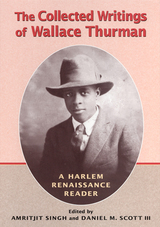 The Collected Writings of Wallace Thurman: A Harlem Renaissance Reader
Singh, Amritjit
Rutgers University Press, 2003 This book is the definitive collection of the writings of Wallace Thurman (1902-1934), providing a comprehensive anthology of both the published and unpublished works of this bohemian, bisexual writer. Widely regarded as the enfant terrible of the Harlem Renaissance scene, Thurman was a leader among a group of young artists and intellectuals that included, among others, Langston Hughes, Zora Neale Hurston, Richard Bruce Nugent, Gwendolyn Bennett, and Aaron Douglas. Through the publication of magazines such as FIRE!! and Harlem: A Forum of Negro Life, Thurman tried to organize the opposition of the younger generation against the programmatic and promotional ideologies of the older generation of black leaders and intellectuals such as W.E.B. Du Bois and Benjamin Brawley. Thurman also left a permanent mark on the period through his prolific work as a novelist, playwright, short story writer, and literary critic, as well as by claiming for himself a voice as a public intellectual. The Collected Writings of Wallace Thurman is divided into eight sections to highlight the variety of genres and styles Thurman practiced as he courageously pursued controversial subjects throughout his short and brilliant career. It includes Essays on Harlem, Social Essays and Journalism, Correspondence, Literary Essays and Reviews, Poetry and Short Fiction, Plays, and Excerpts from Novel.
Filling an important gap in Harlem Renaissance literature, this collection brings together all of Thurman’s essays, nearly all of his letters to major black and white figures of the 1920s, and three previously unpublished major works. These books are Aunt Hagar’s Children, which is a collection of essays and two full-length plays, Harlem, and Jeremiah the Magnificent. The introduction to the volume, along with the carefully researched introductory notes to each of the eight sections, provides a challenging new reevaluation of Thurman and the Harlem Renaissance for both the general reader and scholar.
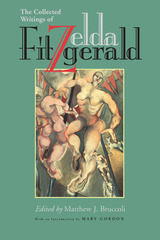 The Collected Writings of Zelda Fitzgerald
Zelda Fitzgerald
University of Alabama Press, 1997 Zelda Sayre Fitzgerald has long been perceived as the tragic "other half" of the Scott and Zelda legend. Born in Montgomery, Alabama, the high-spirited tomboy turned flapper was talented in dance, painting, and writing but lived in the shadow of her husband's success. Her writing can be experienced on its own terms in Matthew Bruccoli's meticulously edited The Collected Writings of Zelda Fitzgerald. The collection includes Zelda's only published novel, Save Me the Waltz, an autobiographical account of the Fitzgeralds' adventures in Paris and on the Riviera; her celebrated farce, Scandalabra; eleven short stories; twelve articles; and a selection of letters to her husband, written over the span of their marriage, that reveals the couple's loving and turbulent relationship. Zelda Sayre Fitzgerald has long been an American cultural icon. The Collected Writings affirms her place as a writer and as a symbol not only of the Lost Generation but of all generations as she struggled to define herself through her art.
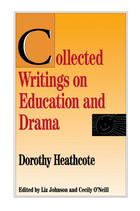 Collected Writings on Education and Drama
Dorothy Heathcote
Northwestern University Press, 1984 What does it mean to be "an excellent teacher?" To Dorothy Heathcote, one of this century's most respected educational innovators, it means seeing one's pupils as they really are, shunning labels and stereotypes. It means taking risks: putting aside one's comfortable, doctrinaire role and participating fully in the learning process. Above all, it means pushing oneself and one's students to the outer limits of capability--often, with miraculous results.
In this lively collection of essays and talks from 1967-80, Heathcote shares the findings of her groundbreaking work in the application of theater techniques and play to classroom teaching. She provides a time-tested philosophy on the value of dramatic activity in breaking down barriers and overcoming inertia. Her insistence that teachers must step down from their pedestals and immerse themselves in the possibility of the moment makes for magical and challenging reading.
 Collecting Antiquity in Modern China: Artifacts and Their Afterlives
Guangchen Chen
University of Chicago Press A look at twentieth-century Chinese writers and intellectuals who used the material remains of the past to unsettle the present.
In this book, Guangchen Chen argues that discerning collectors used antiquities to upend dominant discourses on history and cultural memory in twentieth-century China. Examining four categories of ancient artifacts—“carving” (oracle bones), “rubbing” (imprints of inscriptions and books), “brushing” (calligraphy), and “weaving” (textiles and costumes)—Chen explains how their modern (re)emergences changed our understanding of the relationship between tradition and modernity, textuality and materiality, and the very meaning of “Chineseness.”
Chen considers intellectuals such as Wang Yirong, Liu E, Luo Zhenyu, Wang Guowei, and Chen Mengjia, who played a pivotal role in the oracle bones’ modern reception. He also looks to major literary figures including Lu Xun, whose engagements with textual remnants of the past inspired his critique of Chinese culture; Guo Moruo, whose work on the calligraphic masterpiece Lantingxu contributed to the cultural-political climate that sparked the Cultural Revolution; Shi Zhecun, whose interest in inscriptions on ancient stelae helped him to hold fast to intellectual integrity in the face of political pressure; and Shen Congwen, whose obsession with ancient textiles saved him from committing suicide after his writing fell out of favor. These antiquarians used their collections as a strategy to synchronize historical time and to challenge two dominant yet contrasting ideologies in modern China: a regressive idealization of antiquity and an unquestioning trust in linear progress. During this turbulent period, long-lost artifacts came to function as omens, warnings, and revelations from another time, generating new meanings that were uniquely relevant to the present.
Collecting Cinema, Rewriting Film History: Between the Visible and the Invisible
André Habib
Amsterdam University Press, 2025 The writing of cinema history would not be possible without the contribution of collectors. Whether through their pioneering excavation work or their passionate defence of forgotten productions and artifacts, collectors have had a lasting influence on both the field and the methods of moving image history. Proceeding from a renewed dialogue between international film scholars, collectors, filmmakers, curators, and archivists, this book aims to reveal the extent to which collectors and collections have contributed to both the history and the epistemology of moving images. It showcases specific studies of collecting practices, as well as in-depth interviews with collectors and artists bringing to light the innumerable articulations between collecting cinema and the rewriting of film history.
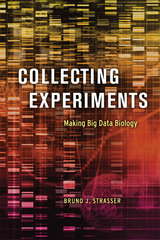 Collecting Experiments: Making Big Data Biology
Bruno J. Strasser
University of Chicago Press, 2019 Databases have revolutionized nearly every aspect of our lives. Information of all sorts is being collected on a massive scale, from Google to Facebook and well beyond. But as the amount of information in databases explodes, we are forced to reassess our ideas about what knowledge is, how it is produced, to whom it belongs, and who can be credited for producing it.
Every scientist working today draws on databases to produce scientific knowledge. Databases have become more common than microscopes, voltmeters, and test tubes, and the increasing amount of data has led to major changes in research practices and profound reflections on the proper professional roles of data producers, collectors, curators, and analysts.
Collecting Experiments traces the development and use of data collections, especially in the experimental life sciences, from the early twentieth century to the present. It shows that the current revolution is best understood as the coming together of two older ways of knowing—collecting and experimenting, the museum and the laboratory. Ultimately, Bruno J. Strasser argues that by serving as knowledge repositories, as well as indispensable tools for producing new knowledge, these databases function as digital museums for the twenty-first century.
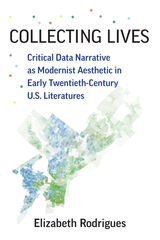 Collecting Lives: Critical Data Narrative as Modernist Aesthetic in Early Twentieth-Century U.S. Literatures
Elizabeth Rodrigues
University of Michigan Press, 2022 On a near-daily basis, data is being used to narrate our lives. Categorizing algorithms draw from amassed personal data to assign narrative destinies to individuals at crucial junctures, simultaneously predicting and shaping the paths of our lives. Data is commonly assumed to bring us closer to objectivity, but the narrative paths these algorithms assign seem, more often than not, to replicate biases about who an individual is and could become. While the social effects of such algorithmic logics seem new and newly urgent to consider, Collecting Lives looks to the late nineteenth and early twentieth century US to provide an instructive prehistory to the underlying question of the relationship between data, life, and narrative. Rodrigues contextualizes the application of data collection to human selfhood in the late nineteenth and early twentieth century US in order to uncover a modernist aesthetic of data that offers an alternative to the algorithmic logic pervading our sense of data’s revelatory potential. Examining the work of W. E. B. Du Bois, Henry Adams, Gertrude Stein, and Ida B. Wells-Barnett, Rodrigues asks how each of these authors draw from their work in sociology, history, psychology, and journalism to formulate a critical data aesthetic as they attempt to answer questions of identity around race, gender, and nation both in their research and their life writing. These data-driven modernists not only tell different life stories with data, they tell life stories differently because of data.
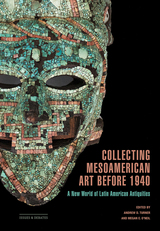 Collecting Mesoamerican Art before 1940: A New World of Latin American Antiquities
Andrew D. Turner
J. Paul Getty Trust, The, 2024 The untold chronicles of the looting and collecting of ancient Mesoamerican objects.
This book traces the fascinating history of how and why ancient Mesoamerican objects have been collected. It begins with the pre-Hispanic antiquities that first entered European collections in the sixteenth century as gifts or seizures, continues through the rise of systematic collecting in Europe and the Americas during the nineteenth and twentieth centuries, and ends in 1940—the start of Europe’s art market collapse at the outbreak of World War II and the coinciding genesis of the large-scale art market for pre-Hispanic antiquities in the United States.
Drawing upon archival resources and international museum collections, the contributors analyze the ways shifting patterns of collecting and taste—including how pre-Hispanic objects changed from being viewed as anthropological and scientific curiosities to collectible artworks—have shaped modern academic disciplines as well as public, private, institutional, and nationalistic attitudes toward Mesoamerican art. As many nations across the world demand the return of their cultural patrimony and ancestral heritage, it is essential to examine the historical processes, events, and actors that initially removed so many objects from their countries of origin.
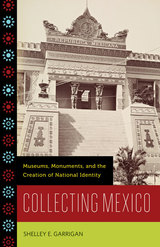 Collecting Mexico: Museums, Monuments, and the Creation of National Identity
Shelley E. Garrigan
University of Minnesota Press, 2012 Collecting Mexico centers on the ways in which aesthetics and commercialism intersected in officially sanctioned public collections and displays in late nineteenth-century Mexico. Shelley E. Garrigan approaches questions of origin, citizenry, membership, and difference by reconstructing the lineage of institutionally collected objects around which a modern Mexican identity was negotiated. In doing so, she arrives at a deeper understanding of the ways in which displayed objects become linked with nationalistic meaning and why they exert such persuasive force. Spanning the Porfiriato period from 1867 to 1910, Collecting Mexico illuminates the creation and institutionalization of a Mexican cultural inheritance. Employing a wide range of examples—including the erection of public monuments, the culture of fine arts, and the representation of Mexico at the Paris World’s Fair of 1889—Garrigan pursues two strands of thought that weave together in surprising ways: national heritage as a transcendental value and patrimony as potential commercial interest. Collecting Mexico shows that the patterns of institutional collecting reveal how Mexican public collections engendered social meaning. Using extensive archival materials, Garrigan’s close readings of the processes of collection building offer a new vantage point for viewing larger issues of identity, social position, and cultural/capital exchange.
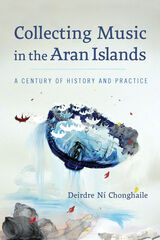 Collecting Music in the Aran Islands: A Century of History and Practice
Deirdre Ní Chonghaile
University of Wisconsin Press, 2022 For more than 150 years, individuals have traveled the countryside with pen, paper, tape recorders, and even video cameras to document versions of songs, music, and stories shared by communities. As technologies and methodologies have advanced, the task of gathering music has been taken up by a much broader group than scholars. The resulting collections created by these various people can be impacted by the individual collectors’ political and social concerns, cultural inclinations, and even simple happenstance, demonstrating a crucial yet underexplored relationship between the music and those preserving it. Collecting Music in the Aran Islands, a critical historiographical study of the practice of documenting traditional music, is the first to focus on the archipelago off the west coast of Ireland. Deirdre Ní Chonghaile argues for a culturally equitable framework that considers negotiation, collaboration, canonization, and marginalization to fully understand the immensely important process of musical curation. In presenting four substantial, historically valuable collections from the nineteenth and twentieth centuries, she illustrates how understanding the motivations and training (or lack thereof) of individual music collectors significantly informs how we should approach their work and contextualize their place in the folk music canon.
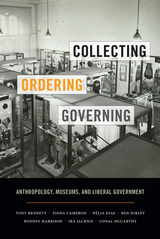 Collecting, Ordering, Governing: Anthropology, Museums, and Liberal Government
Tony Bennett, Fiona Cameron, Nelia Dias, Ben Dibley, Harrison Rodney, Ira Jacknis, and Conal McCarthy
Duke University Press, 2017 The coauthors of this theoretically innovative work explore the relationships among anthropological fieldwork, museum collecting and display, and social governance in the early twentieth century in Australia, Britain, France, New Zealand, and the United States. With case studies ranging from the Musée de l'Homme's 1930s fieldwork missions in French Indo-China to the influence of Franz Boas's culture concept on the development of American museums, the authors illuminate recent debates about postwar forms of multicultural governance, cultural conceptions of difference, and postcolonial policy and practice in museums. Collecting, Ordering, Governing is essential reading for scholars and students of anthropology, museum studies, cultural studies, and indigenous studies as well as museum and heritage professionals.
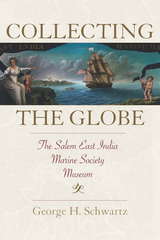 Collecting the Globe: The Salem East India Marine Society Museum
George H. Schwartz
University of Massachusetts Press, 2020 The East India Marine Society Museum was one of the most influential collecting institutions in nineteenth-century America. From 1799 to 1867, when Salem, Massachusetts, was a premier American port and launching pad for international trade, the museum's collection developed at a nexus of global exchange, with donations of artwork, crafts, and flora and fauna pouring in from distant ports of call. At a time when the country was filled with Barnum-esque exhibitions, visitors to this museum could circumnavigate the globe and gain an understanding of the world and their place within it.
Collecting the Globe presents the first in-depth exploration of the East India Marine Society Museum, the precursor to the internationally acclaimed Peabody Essex Museum. Offering fresh perspectives on museums in the United States before the Civil War and how they helped shape an American identity, George H. Schwartz explores the practices of collecting, exhibiting, and interpreting a diversity of international objects and art in the early United States.
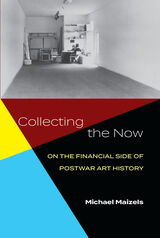 Collecting the Now: On the Financial Side of Postwar Art History
Michael Maizels
University of Michigan Press, 2022 Collecting the Now offers a new, in-depth look at the economic forces and institutional actors that have shaped the outlines of postwar art history, with a particular focus on American art, 1960–1990. Working through four case studies, Michael Maizels illuminates how a set of dealers and patrons conditioned the iconic developments of this period: the profusions of pop art, the quixotic impossibility of land art, the dissemination of new media, and the speculation-fueled neo-expressionist painting of the 1980s.
This book addresses a question of pivotal importance to a swath of art history that has already received substantial scholarly investigation. We now have a clear, nuanced understanding of why certain evolutions took place: why pop artists exploded the delimited parameters of aesthetic modernism, why land artists further strove against the object form itself, and why artists returned to (neo-)traditional painting in the 1980s. But remarkably elided by extant scholarship has been the question of how. How did conditions coalesce around pop so that its artists entered into museum collections, and scholarly analyses, at pace unprecedented in the prior history of art? How, when seeking to transcend the delimited gallery object, were land artists able to create monumental (and by extension, monumentally expensive), interventions in the extreme wilds of the Western deserts? And how did the esoteric objects of media art come eventually to scholarly attention in the sustained absence of academic interest or a private market? The answers to these questions lie in an exploration of the financial conditions and funding mechanisms through which these works were created, advertised, distributed, and preserved.
|
|
